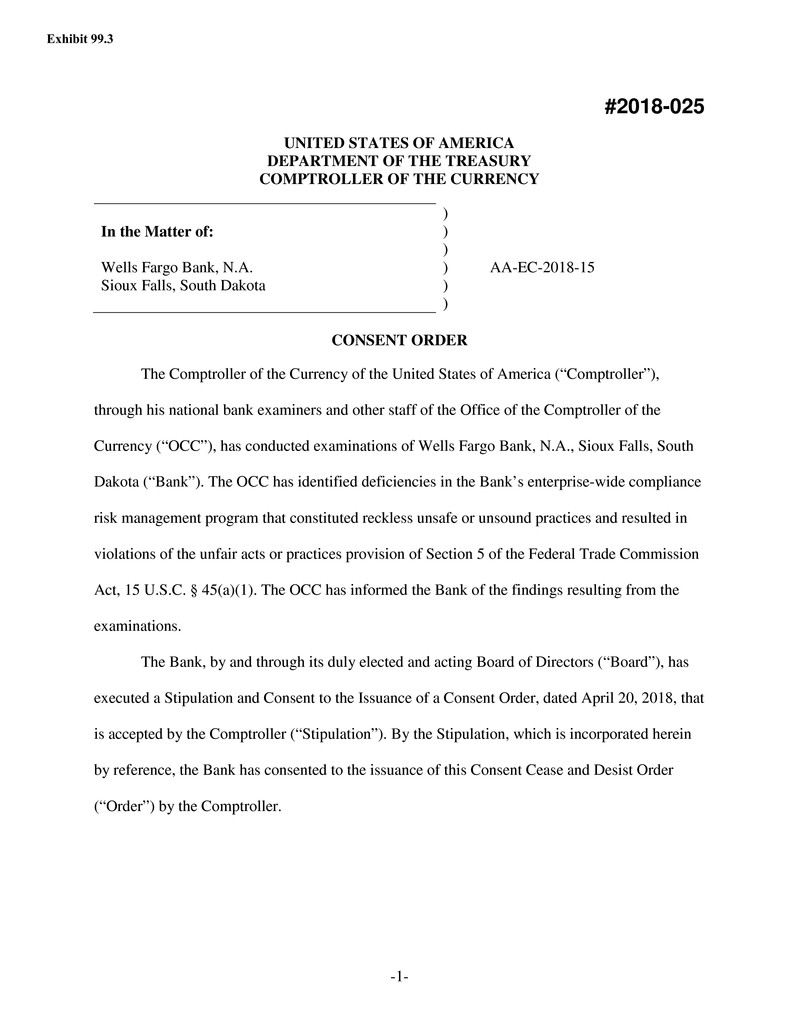
-1- #2018-025 UNITED STATES OF AMERICA DEPARTMENT OF THE TREASURY COMPTROLLER OF THE CURRENCY In the Matter of: Wells Fargo Bank, N.A. Sioux Falls, South Dakota ) ) ) ) ) ) AA-EC-2018-15 CONSENT ORDER The Comptroller of the Currency of the United States of America (“Comptroller”), through his national bank examiners and other staff of the Office of the Comptroller of the Currency (“OCC”), has conducted examinations of Wells Fargo Bank, N.A., Sioux Falls, South Dakota (“Bank”). The OCC has identified deficiencies in the Bank’s enterprise-wide compliance risk management program that constituted reckless unsafe or unsound practices and resulted in violations of the unfair acts or practices provision of Section 5 of the Federal Trade Commission Act, 15 U.S.C. § 45(a)(1). The OCC has informed the Bank of the findings resulting from the examinations. The Bank, by and through its duly elected and acting Board of Directors (“Board”), has executed a Stipulation and Consent to the Issuance of a Consent Order, dated April 20, 2018, that is accepted by the Comptroller (“Stipulation”). By the Stipulation, which is incorporated herein by reference, the Bank has consented to the issuance of this Consent Cease and Desist Order (“Order”) by the Comptroller. Exhibit 99.3
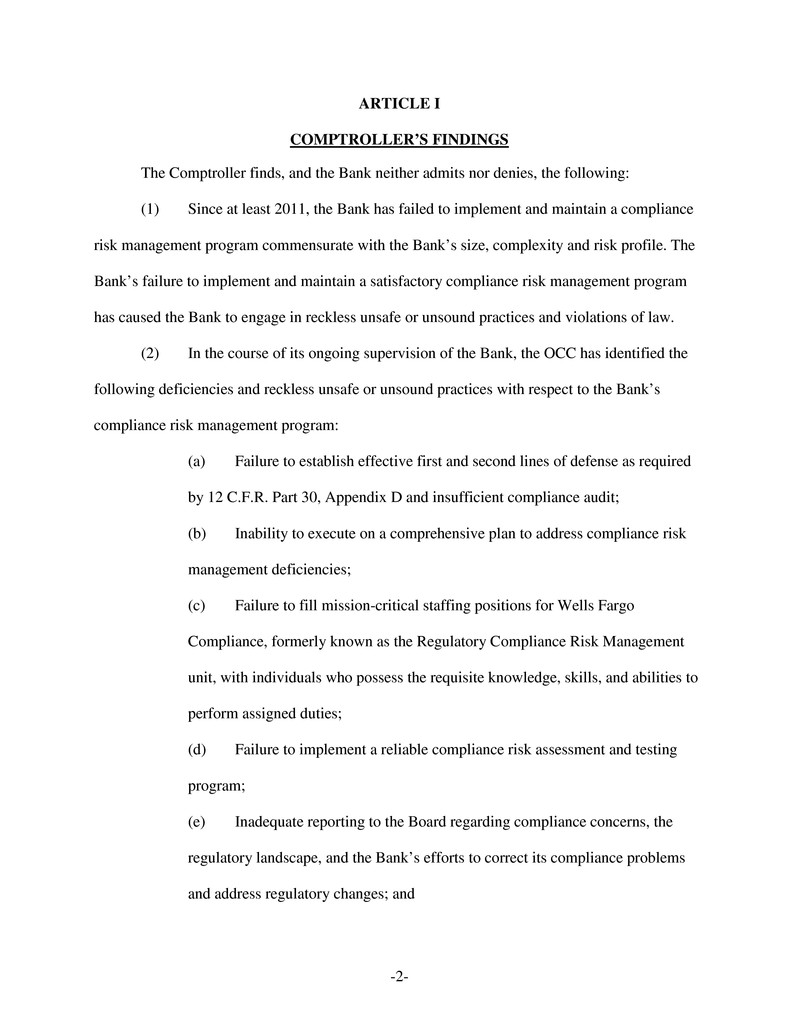
-2- ARTICLE I COMPTROLLER’S FINDINGS The Comptroller finds, and the Bank neither admits nor denies, the following: (1) Since at least 2011, the Bank has failed to implement and maintain a compliance risk management program commensurate with the Bank’s size, complexity and risk profile. The Bank’s failure to implement and maintain a satisfactory compliance risk management program has caused the Bank to engage in reckless unsafe or unsound practices and violations of law. (2) In the course of its ongoing supervision of the Bank, the OCC has identified the following deficiencies and reckless unsafe or unsound practices with respect to the Bank’s compliance risk management program: (a) Failure to establish effective first and second lines of defense as required by 12 C.F.R. Part 30, Appendix D and insufficient compliance audit; (b) Inability to execute on a comprehensive plan to address compliance risk management deficiencies; (c) Failure to fill mission-critical staffing positions for Wells Fargo Compliance, formerly known as the Regulatory Compliance Risk Management unit, with individuals who possess the requisite knowledge, skills, and abilities to perform assigned duties; (d) Failure to implement a reliable compliance risk assessment and testing program; (e) Inadequate reporting to the Board regarding compliance concerns, the regulatory landscape, and the Bank’s efforts to correct its compliance problems and address regulatory changes; and
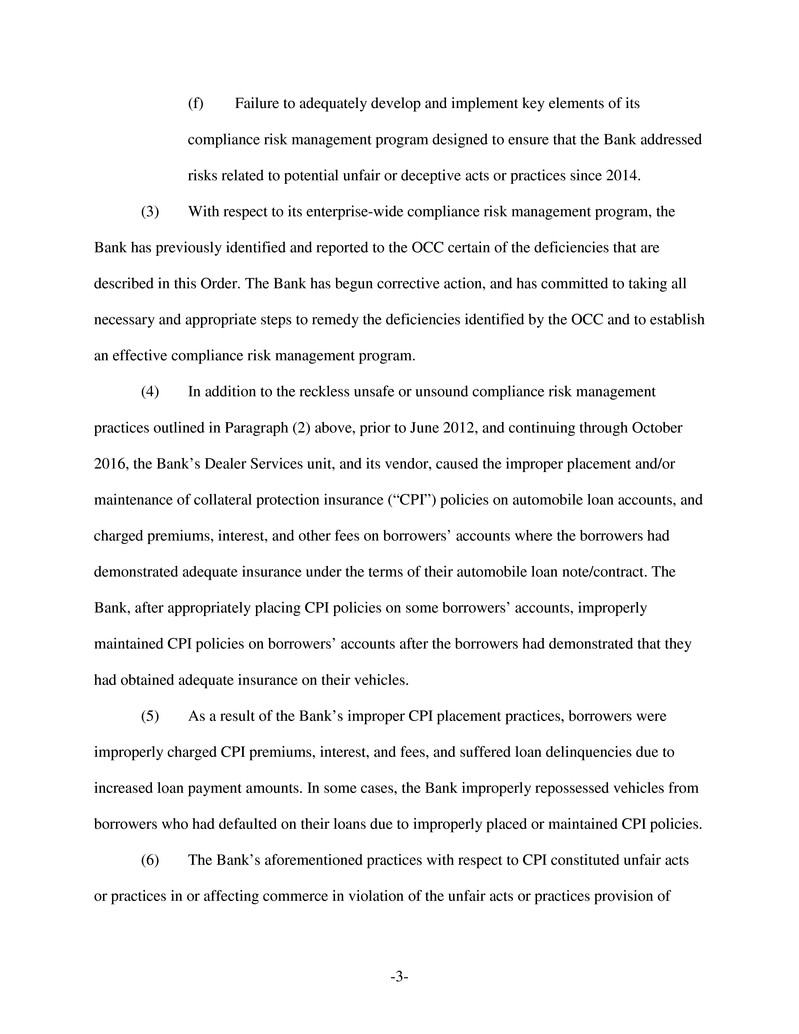
-3- (f) Failure to adequately develop and implement key elements of its compliance risk management program designed to ensure that the Bank addressed risks related to potential unfair or deceptive acts or practices since 2014. (3) With respect to its enterprise-wide compliance risk management program, the Bank has previously identified and reported to the OCC certain of the deficiencies that are described in this Order. The Bank has begun corrective action, and has committed to taking all necessary and appropriate steps to remedy the deficiencies identified by the OCC and to establish an effective compliance risk management program. (4) In addition to the reckless unsafe or unsound compliance risk management practices outlined in Paragraph (2) above, prior to June 2012, and continuing through October 2016, the Bank’s Dealer Services unit, and its vendor, caused the improper placement and/or maintenance of collateral protection insurance (“CPI”) policies on automobile loan accounts, and charged premiums, interest, and other fees on borrowers’ accounts where the borrowers had demonstrated adequate insurance under the terms of their automobile loan note/contract. The Bank, after appropriately placing CPI policies on some borrowers’ accounts, improperly maintained CPI policies on borrowers’ accounts after the borrowers had demonstrated that they had obtained adequate insurance on their vehicles. (5) As a result of the Bank’s improper CPI placement practices, borrowers were improperly charged CPI premiums, interest, and fees, and suffered loan delinquencies due to increased loan payment amounts. In some cases, the Bank improperly repossessed vehicles from borrowers who had defaulted on their loans due to improperly placed or maintained CPI policies. (6) The Bank’s aforementioned practices with respect to CPI constituted unfair acts or practices in or affecting commerce in violation of the unfair acts or practices provision of
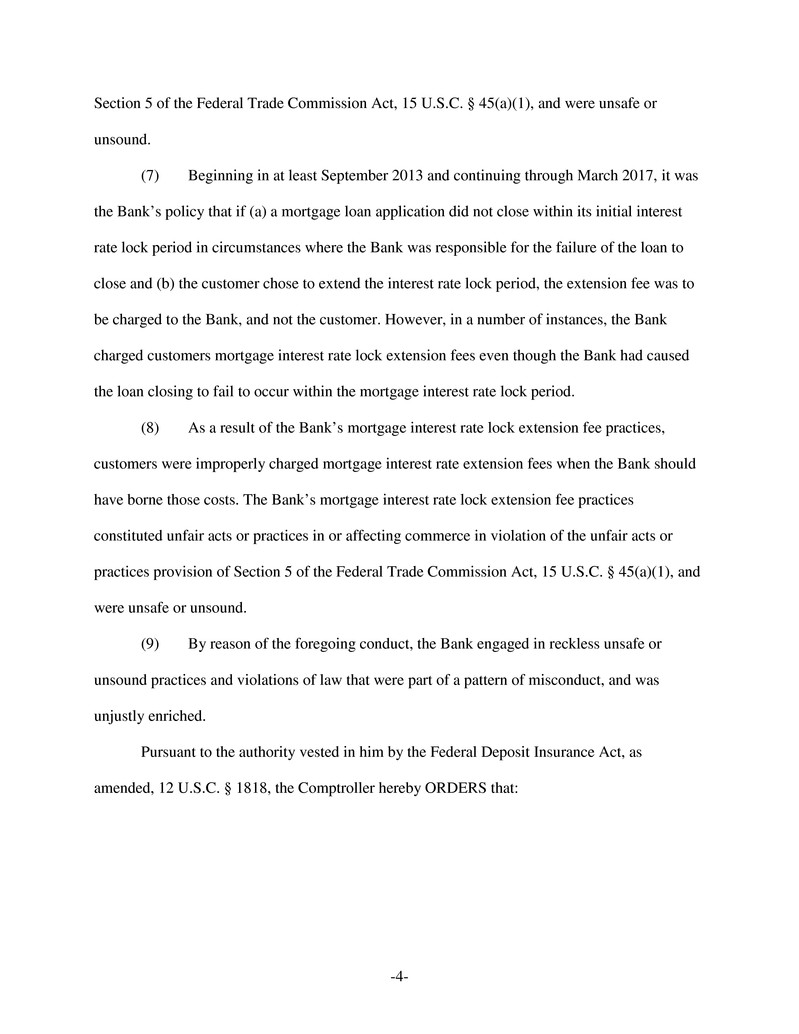
-4- Section 5 of the Federal Trade Commission Act, 15 U.S.C. § 45(a)(1), and were unsafe or unsound. (7) Beginning in at least September 2013 and continuing through March 2017, it was the Bank’s policy that if (a) a mortgage loan application did not close within its initial interest rate lock period in circumstances where the Bank was responsible for the failure of the loan to close and (b) the customer chose to extend the interest rate lock period, the extension fee was to be charged to the Bank, and not the customer. However, in a number of instances, the Bank charged customers mortgage interest rate lock extension fees even though the Bank had caused the loan closing to fail to occur within the mortgage interest rate lock period. (8) As a result of the Bank’s mortgage interest rate lock extension fee practices, customers were improperly charged mortgage interest rate extension fees when the Bank should have borne those costs. The Bank’s mortgage interest rate lock extension fee practices constituted unfair acts or practices in or affecting commerce in violation of the unfair acts or practices provision of Section 5 of the Federal Trade Commission Act, 15 U.S.C. § 45(a)(1), and were unsafe or unsound. (9) By reason of the foregoing conduct, the Bank engaged in reckless unsafe or unsound practices and violations of law that were part of a pattern of misconduct, and was unjustly enriched. Pursuant to the authority vested in him by the Federal Deposit Insurance Act, as amended, 12 U.S.C. § 1818, the Comptroller hereby ORDERS that:
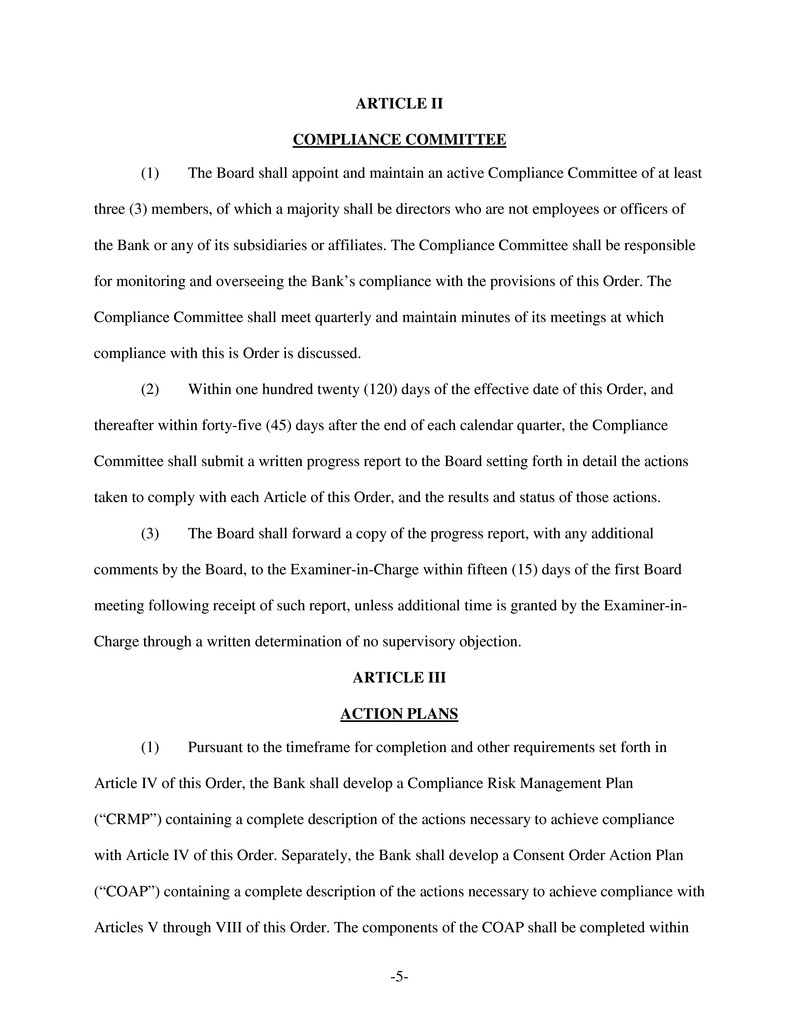
-5- ARTICLE II COMPLIANCE COMMITTEE (1) The Board shall appoint and maintain an active Compliance Committee of at least three (3) members, of which a majority shall be directors who are not employees or officers of the Bank or any of its subsidiaries or affiliates. The Compliance Committee shall be responsible for monitoring and overseeing the Bank’s compliance with the provisions of this Order. The Compliance Committee shall meet quarterly and maintain minutes of its meetings at which compliance with this is Order is discussed. (2) Within one hundred twenty (120) days of the effective date of this Order, and thereafter within forty-five (45) days after the end of each calendar quarter, the Compliance Committee shall submit a written progress report to the Board setting forth in detail the actions taken to comply with each Article of this Order, and the results and status of those actions. (3) The Board shall forward a copy of the progress report, with any additional comments by the Board, to the Examiner-in-Charge within fifteen (15) days of the first Board meeting following receipt of such report, unless additional time is granted by the Examiner-in- Charge through a written determination of no supervisory objection. ARTICLE III ACTION PLANS (1) Pursuant to the timeframe for completion and other requirements set forth in Article IV of this Order, the Bank shall develop a Compliance Risk Management Plan (“CRMP”) containing a complete description of the actions necessary to achieve compliance with Article IV of this Order. Separately, the Bank shall develop a Consent Order Action Plan (“COAP”) containing a complete description of the actions necessary to achieve compliance with Articles V through VIII of this Order. The components of the COAP shall be completed within
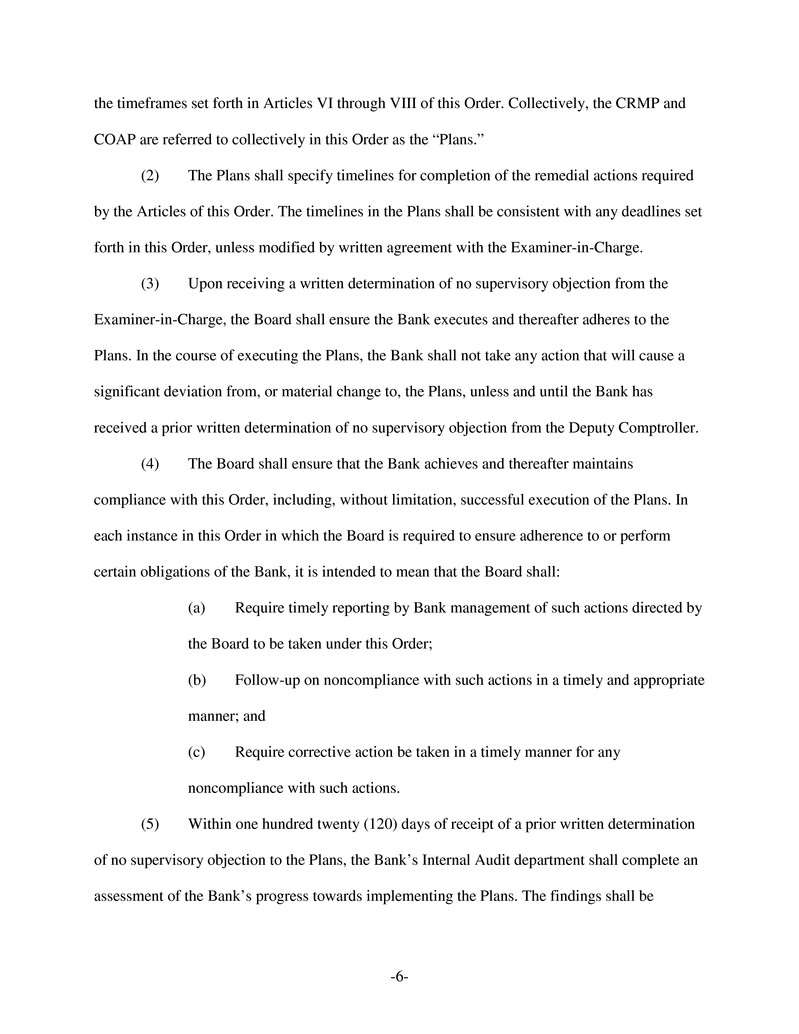
-6- the timeframes set forth in Articles VI through VIII of this Order. Collectively, the CRMP and COAP are referred to collectively in this Order as the “Plans.” (2) The Plans shall specify timelines for completion of the remedial actions required by the Articles of this Order. The timelines in the Plans shall be consistent with any deadlines set forth in this Order, unless modified by written agreement with the Examiner-in-Charge. (3) Upon receiving a written determination of no supervisory objection from the Examiner-in-Charge, the Board shall ensure the Bank executes and thereafter adheres to the Plans. In the course of executing the Plans, the Bank shall not take any action that will cause a significant deviation from, or material change to, the Plans, unless and until the Bank has received a prior written determination of no supervisory objection from the Deputy Comptroller. (4) The Board shall ensure that the Bank achieves and thereafter maintains compliance with this Order, including, without limitation, successful execution of the Plans. In each instance in this Order in which the Board is required to ensure adherence to or perform certain obligations of the Bank, it is intended to mean that the Board shall: (a) Require timely reporting by Bank management of such actions directed by the Board to be taken under this Order; (b) Follow-up on noncompliance with such actions in a timely and appropriate manner; and (c) Require corrective action be taken in a timely manner for any noncompliance with such actions. (5) Within one hundred twenty (120) days of receipt of a prior written determination of no supervisory objection to the Plans, the Bank’s Internal Audit department shall complete an assessment of the Bank’s progress towards implementing the Plans. The findings shall be
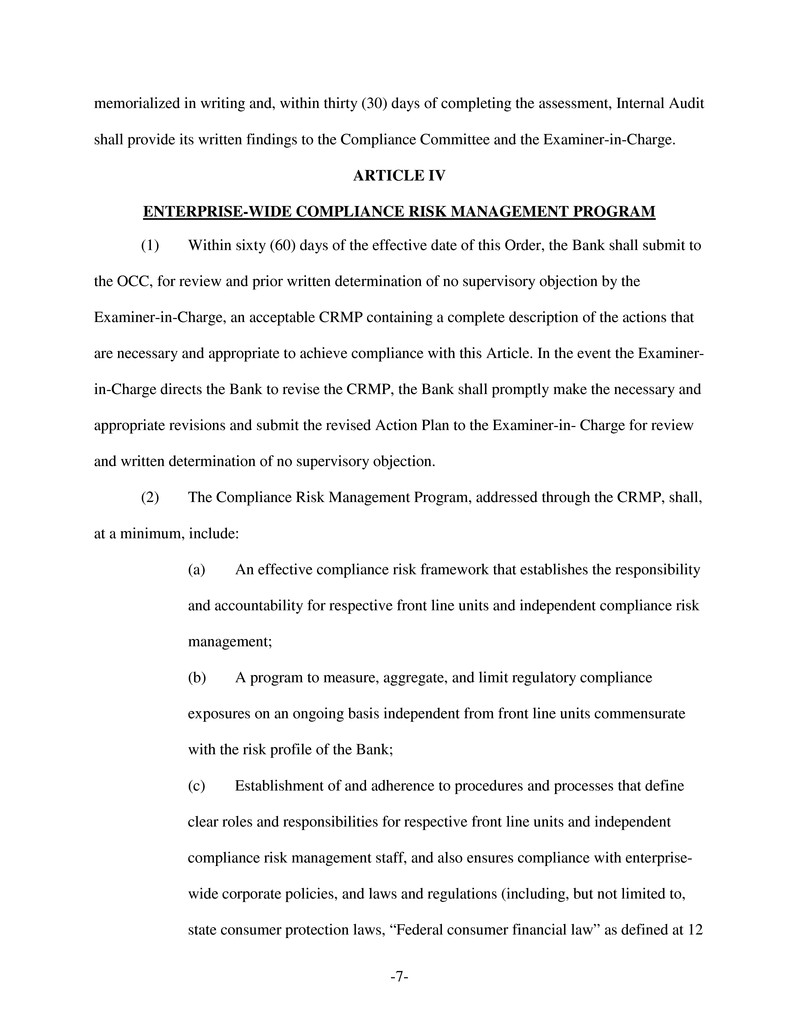
-7- memorialized in writing and, within thirty (30) days of completing the assessment, Internal Audit shall provide its written findings to the Compliance Committee and the Examiner-in-Charge. ARTICLE IV ENTERPRISE-WIDE COMPLIANCE RISK MANAGEMENT PROGRAM (1) Within sixty (60) days of the effective date of this Order, the Bank shall submit to the OCC, for review and prior written determination of no supervisory objection by the Examiner-in-Charge, an acceptable CRMP containing a complete description of the actions that are necessary and appropriate to achieve compliance with this Article. In the event the Examiner- in-Charge directs the Bank to revise the CRMP, the Bank shall promptly make the necessary and appropriate revisions and submit the revised Action Plan to the Examiner-in- Charge for review and written determination of no supervisory objection. (2) The Compliance Risk Management Program, addressed through the CRMP, shall, at a minimum, include: (a) An effective compliance risk framework that establishes the responsibility and accountability for respective front line units and independent compliance risk management; (b) A program to measure, aggregate, and limit regulatory compliance exposures on an ongoing basis independent from front line units commensurate with the risk profile of the Bank; (c) Establishment of and adherence to procedures and processes that define clear roles and responsibilities for respective front line units and independent compliance risk management staff, and also ensures compliance with enterprise- wide corporate policies, and laws and regulations (including, but not limited to, state consumer protection laws, “Federal consumer financial law” as defined at 12
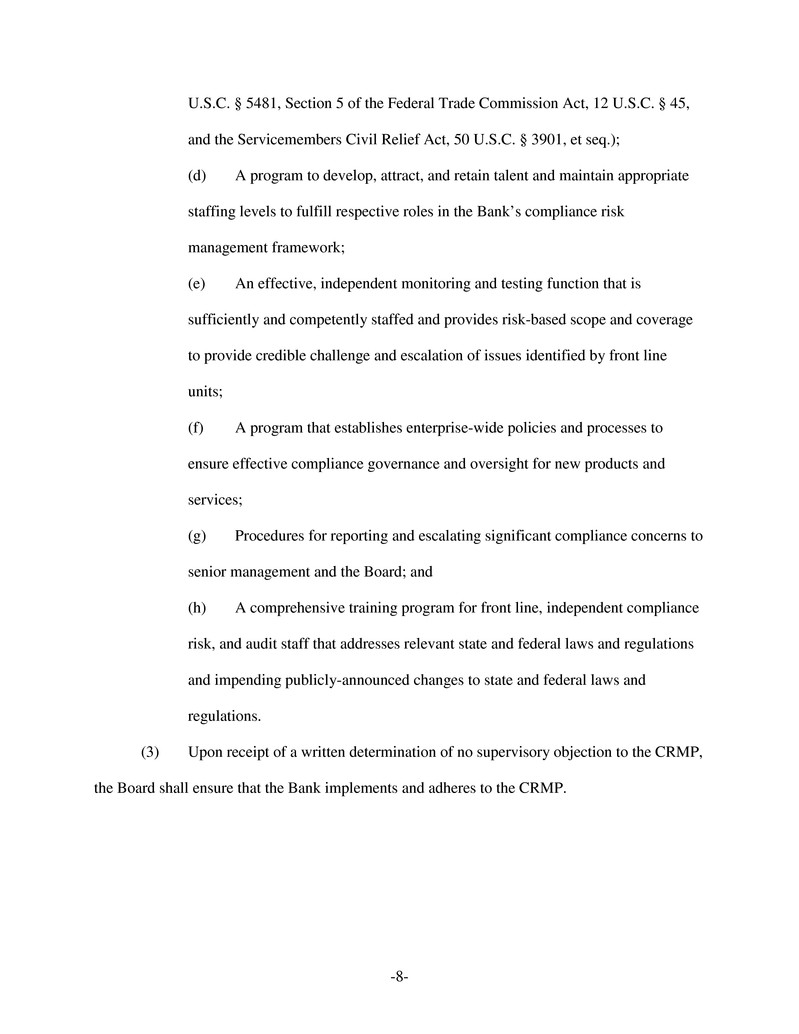
-8- U.S.C. § 5481, Section 5 of the Federal Trade Commission Act, 12 U.S.C. § 45, and the Servicemembers Civil Relief Act, 50 U.S.C. § 3901, et seq.); (d) A program to develop, attract, and retain talent and maintain appropriate staffing levels to fulfill respective roles in the Bank’s compliance risk management framework; (e) An effective, independent monitoring and testing function that is sufficiently and competently staffed and provides risk-based scope and coverage to provide credible challenge and escalation of issues identified by front line units; (f) A program that establishes enterprise-wide policies and processes to ensure effective compliance governance and oversight for new products and services; (g) Procedures for reporting and escalating significant compliance concerns to senior management and the Board; and (h) A comprehensive training program for front line, independent compliance risk, and audit staff that addresses relevant state and federal laws and regulations and impending publicly-announced changes to state and federal laws and regulations. (3) Upon receipt of a written determination of no supervisory objection to the CRMP, the Board shall ensure that the Bank implements and adheres to the CRMP.
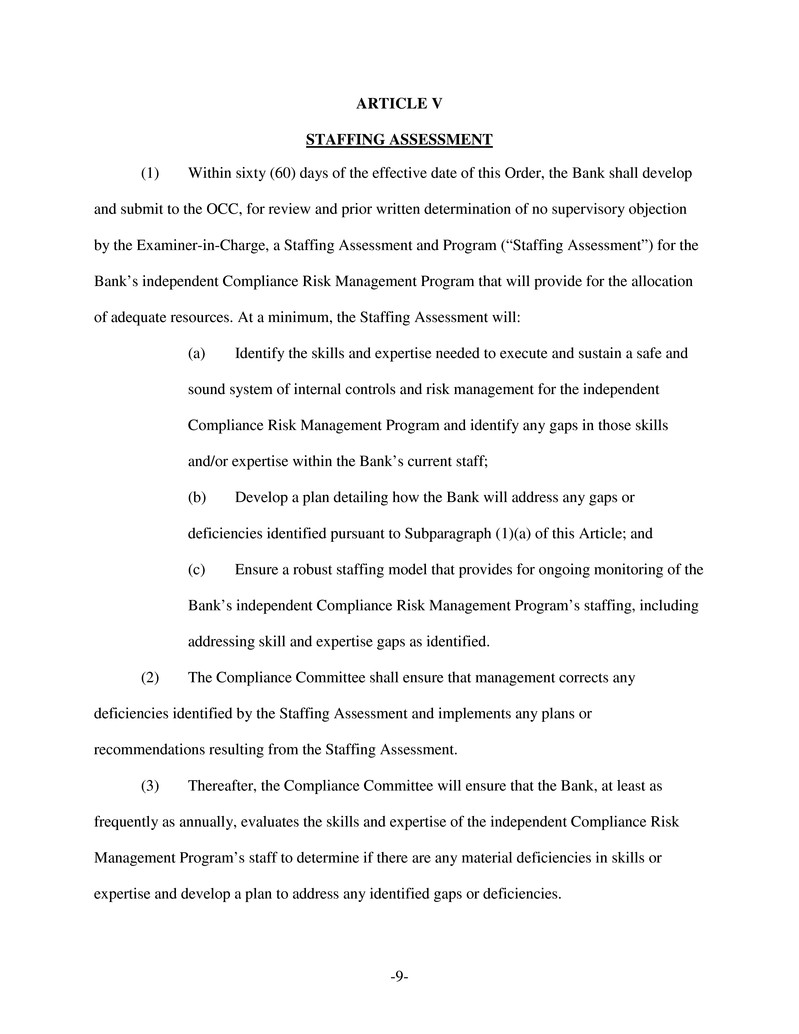
-9- ARTICLE V STAFFING ASSESSMENT (1) Within sixty (60) days of the effective date of this Order, the Bank shall develop and submit to the OCC, for review and prior written determination of no supervisory objection by the Examiner-in-Charge, a Staffing Assessment and Program (“Staffing Assessment”) for the Bank’s independent Compliance Risk Management Program that will provide for the allocation of adequate resources. At a minimum, the Staffing Assessment will: (a) Identify the skills and expertise needed to execute and sustain a safe and sound system of internal controls and risk management for the independent Compliance Risk Management Program and identify any gaps in those skills and/or expertise within the Bank’s current staff; (b) Develop a plan detailing how the Bank will address any gaps or deficiencies identified pursuant to Subparagraph (1)(a) of this Article; and (c) Ensure a robust staffing model that provides for ongoing monitoring of the Bank’s independent Compliance Risk Management Program’s staffing, including addressing skill and expertise gaps as identified. (2) The Compliance Committee shall ensure that management corrects any deficiencies identified by the Staffing Assessment and implements any plans or recommendations resulting from the Staffing Assessment. (3) Thereafter, the Compliance Committee will ensure that the Bank, at least as frequently as annually, evaluates the skills and expertise of the independent Compliance Risk Management Program’s staff to determine if there are any material deficiencies in skills or expertise and develop a plan to address any identified gaps or deficiencies.
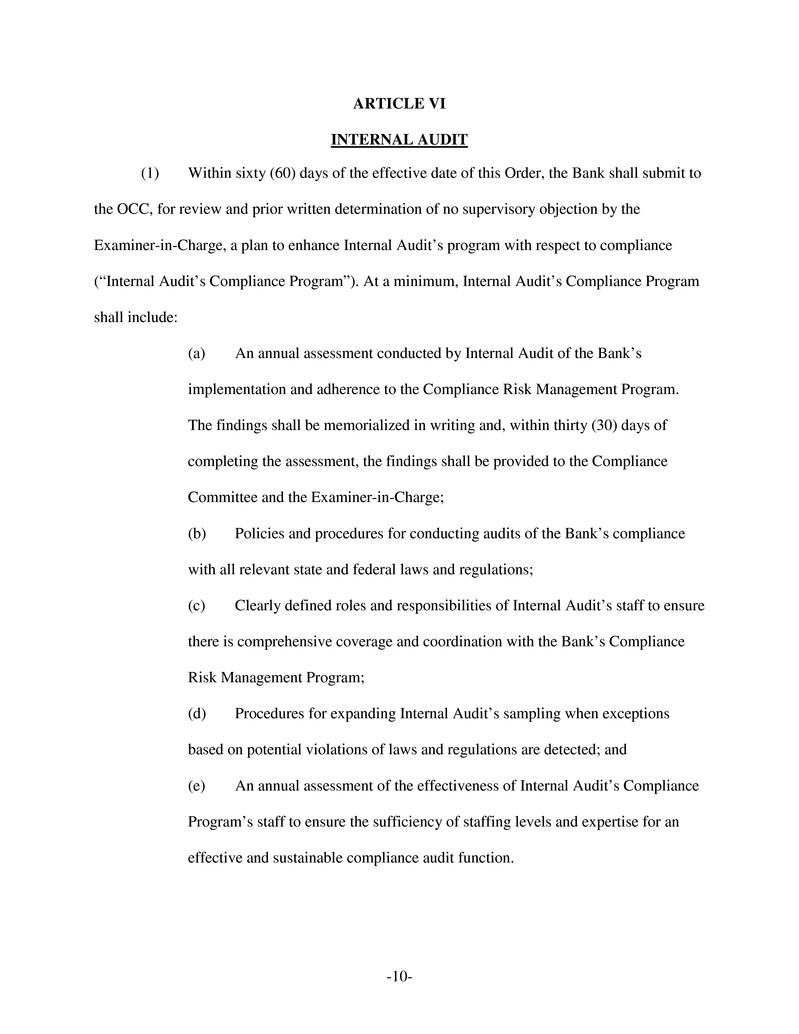
-10- ARTICLE VI INTERNAL AUDIT (1) Within sixty (60) days of the effective date of this Order, the Bank shall submit to the OCC, for review and prior written determination of no supervisory objection by the Examiner-in-Charge, a plan to enhance Internal Audit’s program with respect to compliance (“Internal Audit’s Compliance Program”). At a minimum, Internal Audit’s Compliance Program shall include: (a) An annual assessment conducted by Internal Audit of the Bank’s implementation and adherence to the Compliance Risk Management Program. The findings shall be memorialized in writing and, within thirty (30) days of completing the assessment, the findings shall be provided to the Compliance Committee and the Examiner-in-Charge; (b) Policies and procedures for conducting audits of the Bank’s compliance with all relevant state and federal laws and regulations; (c) Clearly defined roles and responsibilities of Internal Audit’s staff to ensure there is comprehensive coverage and coordination with the Bank’s Compliance Risk Management Program; (d) Procedures for expanding Internal Audit’s sampling when exceptions based on potential violations of laws and regulations are detected; and (e) An annual assessment of the effectiveness of Internal Audit’s Compliance Program’s staff to ensure the sufficiency of staffing levels and expertise for an effective and sustainable compliance audit function.
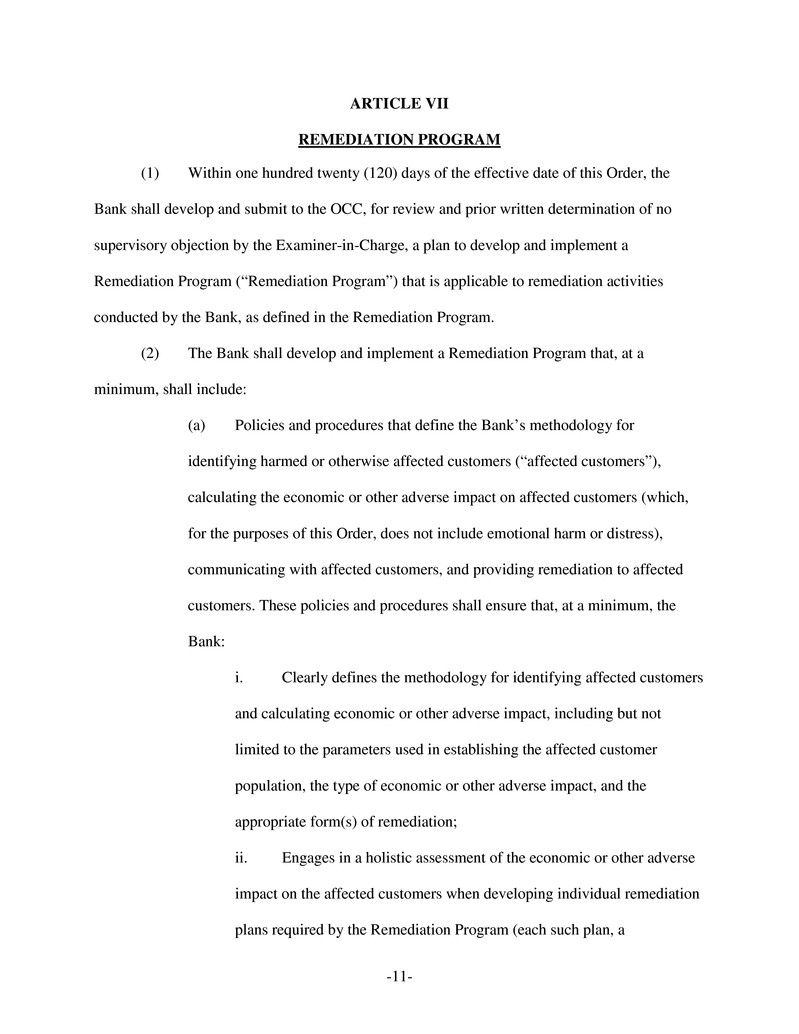
-11- ARTICLE VII REMEDIATION PROGRAM (1) Within one hundred twenty (120) days of the effective date of this Order, the Bank shall develop and submit to the OCC, for review and prior written determination of no supervisory objection by the Examiner-in-Charge, a plan to develop and implement a Remediation Program (“Remediation Program”) that is applicable to remediation activities conducted by the Bank, as defined in the Remediation Program. (2) The Bank shall develop and implement a Remediation Program that, at a minimum, shall include: (a) Policies and procedures that define the Bank’s methodology for identifying harmed or otherwise affected customers (“affected customers”), calculating the economic or other adverse impact on affected customers (which, for the purposes of this Order, does not include emotional harm or distress), communicating with affected customers, and providing remediation to affected customers. These policies and procedures shall ensure that, at a minimum, the Bank: i. Clearly defines the methodology for identifying affected customers and calculating economic or other adverse impact, including but not limited to the parameters used in establishing the affected customer population, the type of economic or other adverse impact, and the appropriate form(s) of remediation; ii. Engages in a holistic assessment of the economic or other adverse impact on the affected customers when developing individual remediation plans required by the Remediation Program (each such plan, a
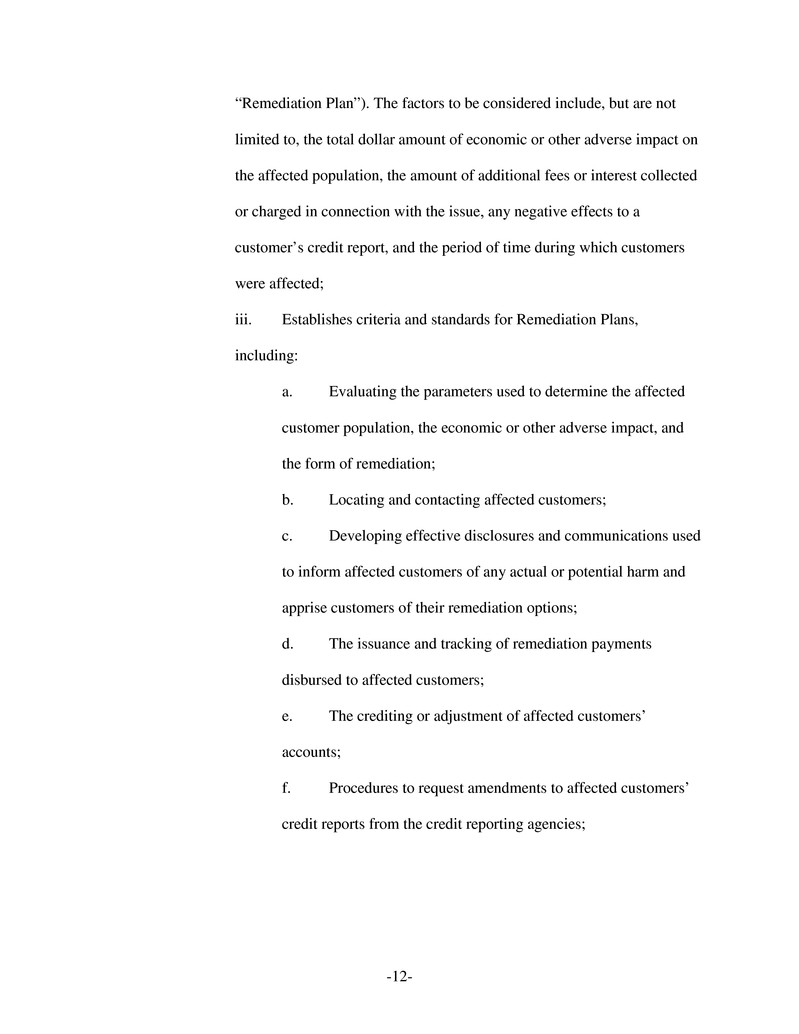
-12- “Remediation Plan”). The factors to be considered include, but are not limited to, the total dollar amount of economic or other adverse impact on the affected population, the amount of additional fees or interest collected or charged in connection with the issue, any negative effects to a customer’s credit report, and the period of time during which customers were affected; iii. Establishes criteria and standards for Remediation Plans, including: a. Evaluating the parameters used to determine the affected customer population, the economic or other adverse impact, and the form of remediation; b. Locating and contacting affected customers; c. Developing effective disclosures and communications used to inform affected customers of any actual or potential harm and apprise customers of their remediation options; d. The issuance and tracking of remediation payments disbursed to affected customers; e. The crediting or adjustment of affected customers’ accounts; f. Procedures to request amendments to affected customers’ credit reports from the credit reporting agencies;
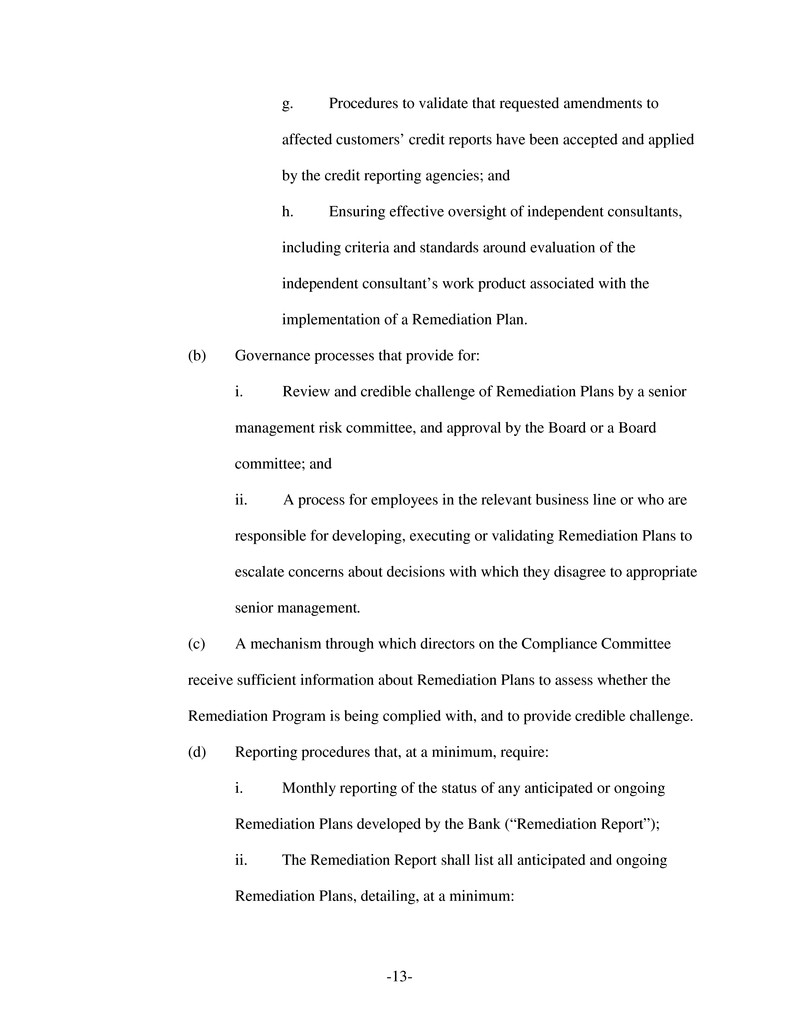
-13- g. Procedures to validate that requested amendments to affected customers’ credit reports have been accepted and applied by the credit reporting agencies; and h. Ensuring effective oversight of independent consultants, including criteria and standards around evaluation of the independent consultant’s work product associated with the implementation of a Remediation Plan. (b) Governance processes that provide for: i. Review and credible challenge of Remediation Plans by a senior management risk committee, and approval by the Board or a Board committee; and ii. A process for employees in the relevant business line or who are responsible for developing, executing or validating Remediation Plans to escalate concerns about decisions with which they disagree to appropriate senior management. (c) A mechanism through which directors on the Compliance Committee receive sufficient information about Remediation Plans to assess whether the Remediation Program is being complied with, and to provide credible challenge. (d) Reporting procedures that, at a minimum, require: i. Monthly reporting of the status of any anticipated or ongoing Remediation Plans developed by the Bank (“Remediation Report”); ii. The Remediation Report shall list all anticipated and ongoing Remediation Plans, detailing, at a minimum:
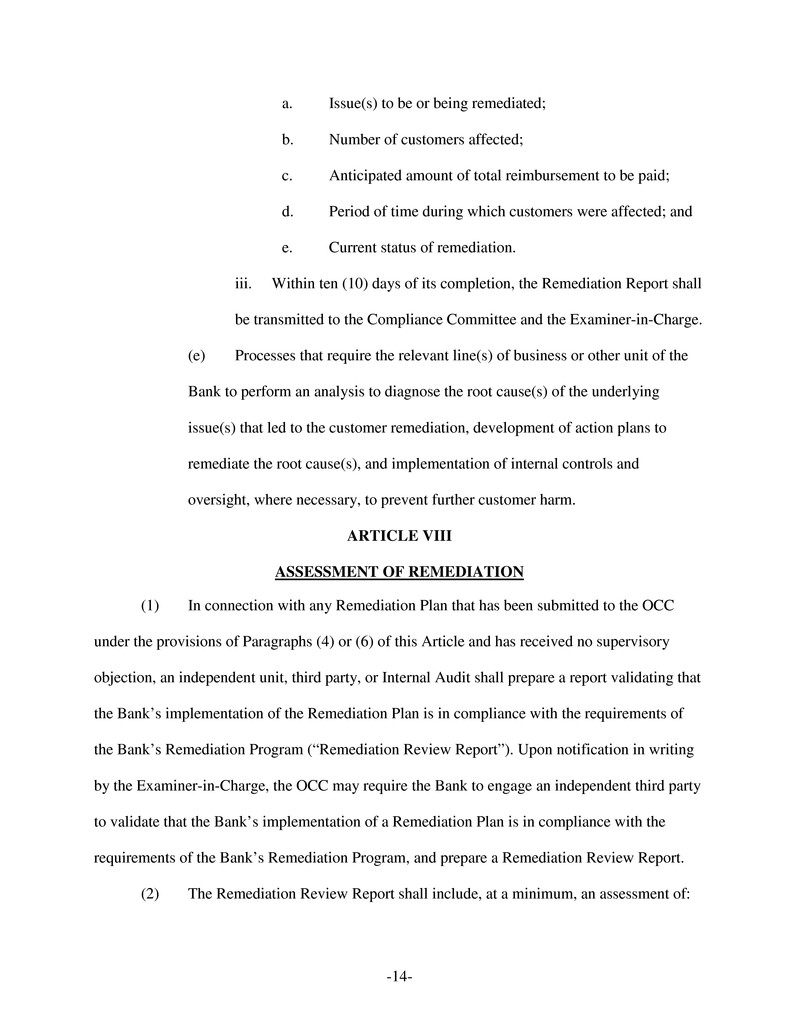
-14- a. Issue(s) to be or being remediated; b. Number of customers affected; c. Anticipated amount of total reimbursement to be paid; d. Period of time during which customers were affected; and e. Current status of remediation. iii. Within ten (10) days of its completion, the Remediation Report shall be transmitted to the Compliance Committee and the Examiner-in-Charge. (e) Processes that require the relevant line(s) of business or other unit of the Bank to perform an analysis to diagnose the root cause(s) of the underlying issue(s) that led to the customer remediation, development of action plans to remediate the root cause(s), and implementation of internal controls and oversight, where necessary, to prevent further customer harm. ARTICLE VIII ASSESSMENT OF REMEDIATION (1) In connection with any Remediation Plan that has been submitted to the OCC under the provisions of Paragraphs (4) or (6) of this Article and has received no supervisory objection, an independent unit, third party, or Internal Audit shall prepare a report validating that the Bank’s implementation of the Remediation Plan is in compliance with the requirements of the Bank’s Remediation Program (“Remediation Review Report”). Upon notification in writing by the Examiner-in-Charge, the OCC may require the Bank to engage an independent third party to validate that the Bank’s implementation of a Remediation Plan is in compliance with the requirements of the Bank’s Remediation Program, and prepare a Remediation Review Report. (2) The Remediation Review Report shall include, at a minimum, an assessment of:
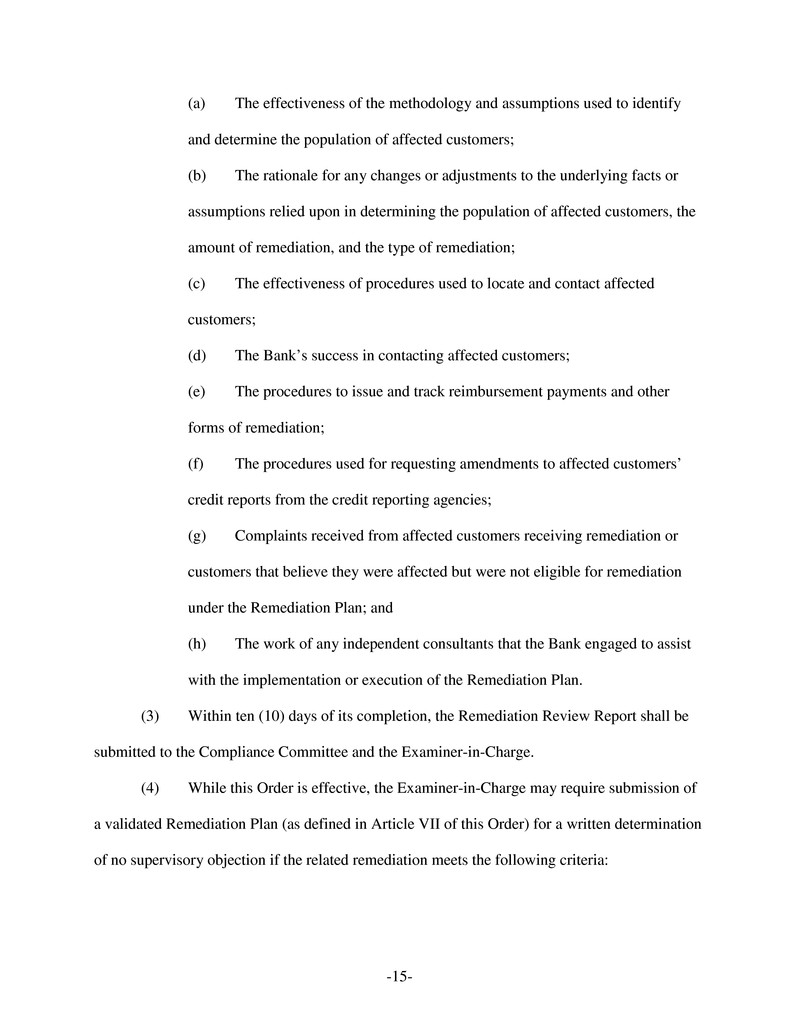
-15- (a) The effectiveness of the methodology and assumptions used to identify and determine the population of affected customers; (b) The rationale for any changes or adjustments to the underlying facts or assumptions relied upon in determining the population of affected customers, the amount of remediation, and the type of remediation; (c) The effectiveness of procedures used to locate and contact affected customers; (d) The Bank’s success in contacting affected customers; (e) The procedures to issue and track reimbursement payments and other forms of remediation; (f) The procedures used for requesting amendments to affected customers’ credit reports from the credit reporting agencies; (g) Complaints received from affected customers receiving remediation or customers that believe they were affected but were not eligible for remediation under the Remediation Plan; and (h) The work of any independent consultants that the Bank engaged to assist with the implementation or execution of the Remediation Plan. (3) Within ten (10) days of its completion, the Remediation Review Report shall be submitted to the Compliance Committee and the Examiner-in-Charge. (4) While this Order is effective, the Examiner-in-Charge may require submission of a validated Remediation Plan (as defined in Article VII of this Order) for a written determination of no supervisory objection if the related remediation meets the following criteria:
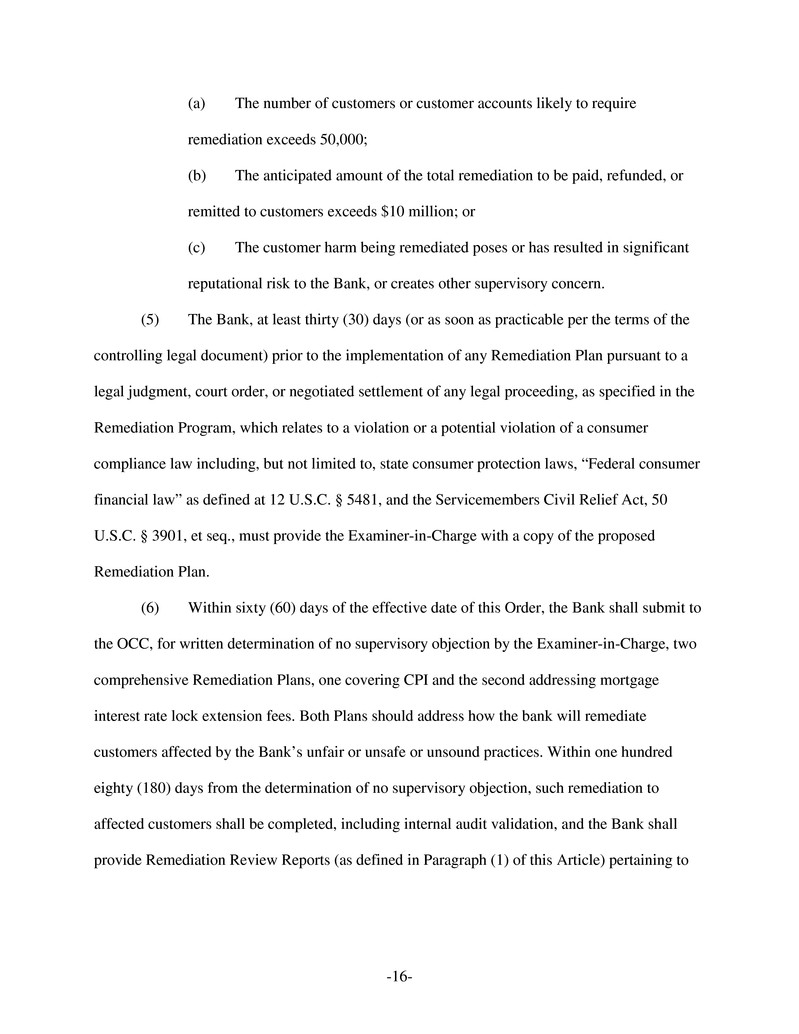
-16- (a) The number of customers or customer accounts likely to require remediation exceeds 50,000; (b) The anticipated amount of the total remediation to be paid, refunded, or remitted to customers exceeds $10 million; or (c) The customer harm being remediated poses or has resulted in significant reputational risk to the Bank, or creates other supervisory concern. (5) The Bank, at least thirty (30) days (or as soon as practicable per the terms of the controlling legal document) prior to the implementation of any Remediation Plan pursuant to a legal judgment, court order, or negotiated settlement of any legal proceeding, as specified in the Remediation Program, which relates to a violation or a potential violation of a consumer compliance law including, but not limited to, state consumer protection laws, “Federal consumer financial law” as defined at 12 U.S.C. § 5481, and the Servicemembers Civil Relief Act, 50 U.S.C. § 3901, et seq., must provide the Examiner-in-Charge with a copy of the proposed Remediation Plan. (6) Within sixty (60) days of the effective date of this Order, the Bank shall submit to the OCC, for written determination of no supervisory objection by the Examiner-in-Charge, two comprehensive Remediation Plans, one covering CPI and the second addressing mortgage interest rate lock extension fees. Both Plans should address how the bank will remediate customers affected by the Bank’s unfair or unsafe or unsound practices. Within one hundred eighty (180) days from the determination of no supervisory objection, such remediation to affected customers shall be completed, including internal audit validation, and the Bank shall provide Remediation Review Reports (as defined in Paragraph (1) of this Article) pertaining to
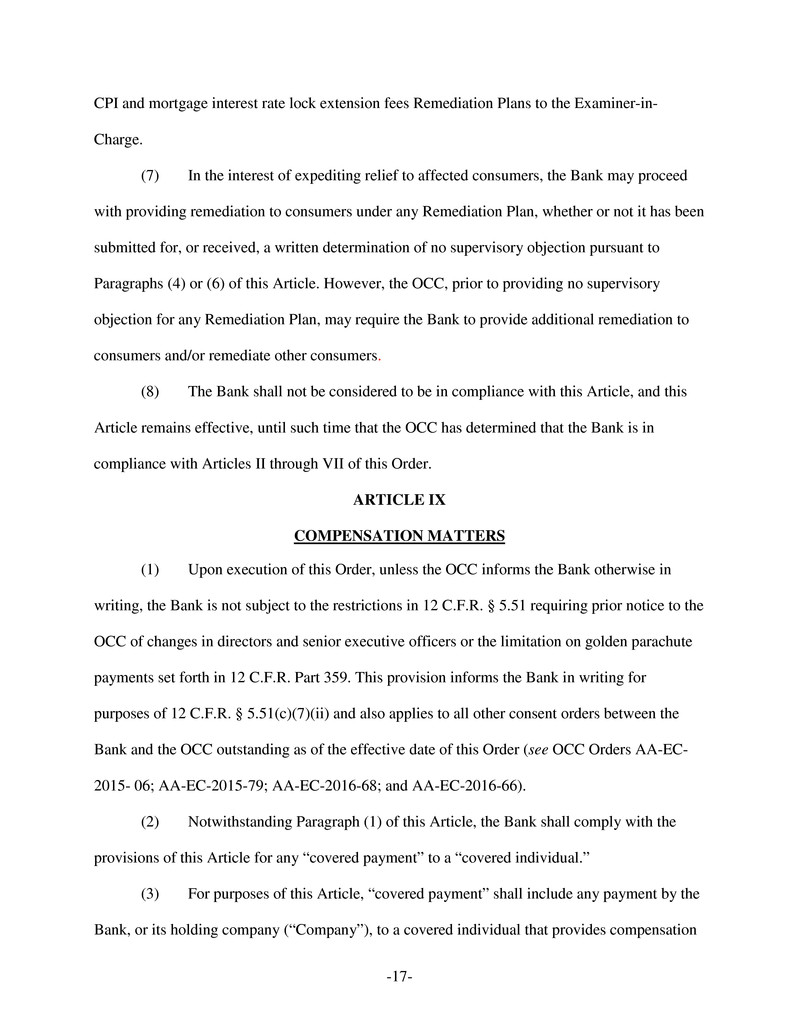
-17- CPI and mortgage interest rate lock extension fees Remediation Plans to the Examiner-in- Charge. (7) In the interest of expediting relief to affected consumers, the Bank may proceed with providing remediation to consumers under any Remediation Plan, whether or not it has been submitted for, or received, a written determination of no supervisory objection pursuant to Paragraphs (4) or (6) of this Article. However, the OCC, prior to providing no supervisory objection for any Remediation Plan, may require the Bank to provide additional remediation to consumers and/or remediate other consumers. (8) The Bank shall not be considered to be in compliance with this Article, and this Article remains effective, until such time that the OCC has determined that the Bank is in compliance with Articles II through VII of this Order. ARTICLE IX COMPENSATION MATTERS (1) Upon execution of this Order, unless the OCC informs the Bank otherwise in writing, the Bank is not subject to the restrictions in 12 C.F.R. § 5.51 requiring prior notice to the OCC of changes in directors and senior executive officers or the limitation on golden parachute payments set forth in 12 C.F.R. Part 359. This provision informs the Bank in writing for purposes of 12 C.F.R. § 5.51(c)(7)(ii) and also applies to all other consent orders between the Bank and the OCC outstanding as of the effective date of this Order (see OCC Orders AA-EC- 2015- 06; AA-EC-2015-79; AA-EC-2016-68; and AA-EC-2016-66). (2) Notwithstanding Paragraph (1) of this Article, the Bank shall comply with the provisions of this Article for any “covered payment” to a “covered individual.” (3) For purposes of this Article, “covered payment” shall include any payment by the Bank, or its holding company (“Company”), to a covered individual that provides compensation
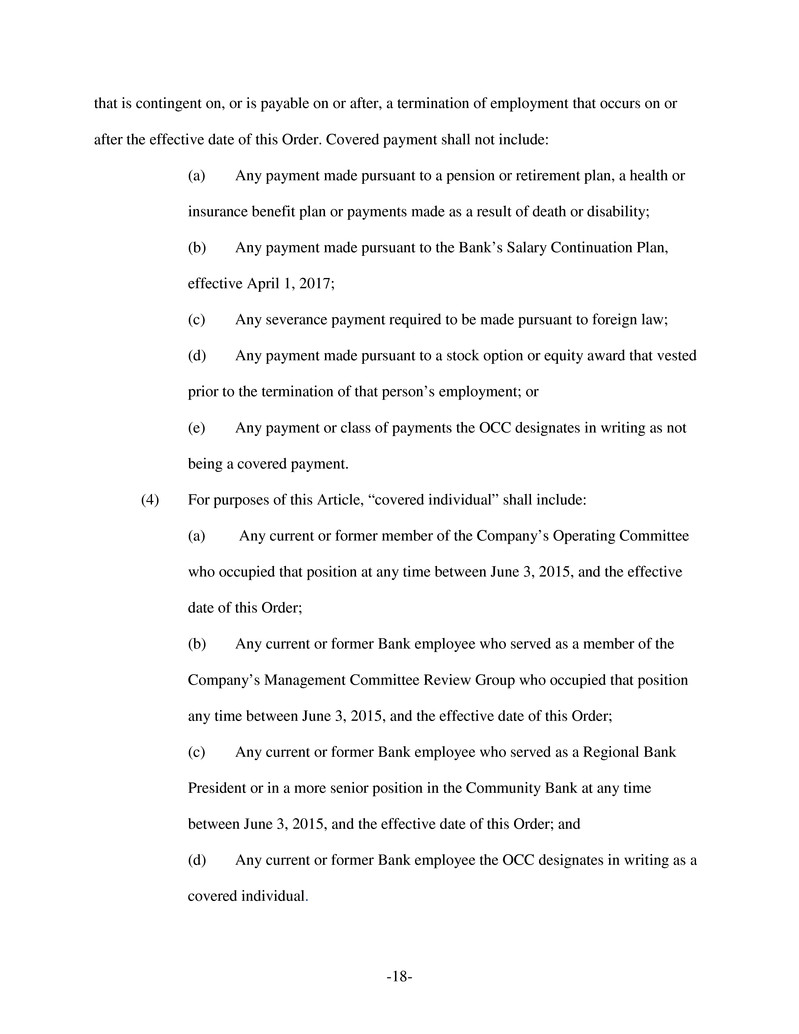
-18- that is contingent on, or is payable on or after, a termination of employment that occurs on or after the effective date of this Order. Covered payment shall not include: (a) Any payment made pursuant to a pension or retirement plan, a health or insurance benefit plan or payments made as a result of death or disability; (b) Any payment made pursuant to the Bank’s Salary Continuation Plan, effective April 1, 2017; (c) Any severance payment required to be made pursuant to foreign law; (d) Any payment made pursuant to a stock option or equity award that vested prior to the termination of that person’s employment; or (e) Any payment or class of payments the OCC designates in writing as not being a covered payment. (4) For purposes of this Article, “covered individual” shall include: (a) Any current or former member of the Company’s Operating Committee who occupied that position at any time between June 3, 2015, and the effective date of this Order; (b) Any current or former Bank employee who served as a member of the Company’s Management Committee Review Group who occupied that position any time between June 3, 2015, and the effective date of this Order; (c) Any current or former Bank employee who served as a Regional Bank President or in a more senior position in the Community Bank at any time between June 3, 2015, and the effective date of this Order; and (d) Any current or former Bank employee the OCC designates in writing as a covered individual.
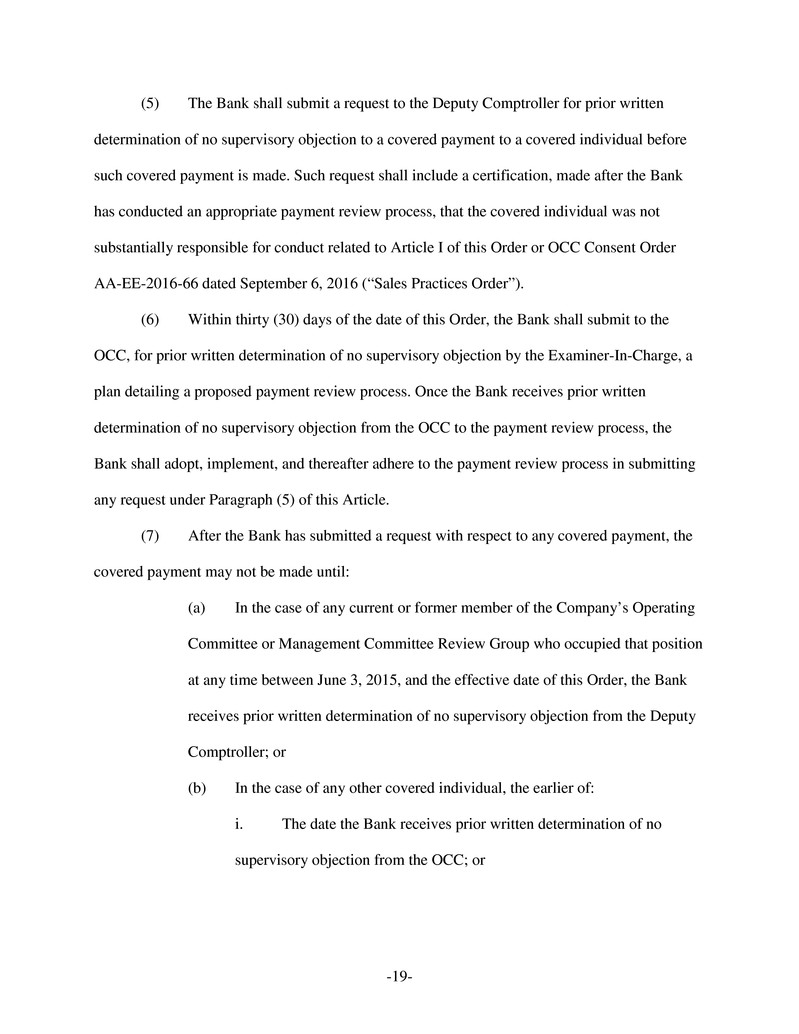
-19- (5) The Bank shall submit a request to the Deputy Comptroller for prior written determination of no supervisory objection to a covered payment to a covered individual before such covered payment is made. Such request shall include a certification, made after the Bank has conducted an appropriate payment review process, that the covered individual was not substantially responsible for conduct related to Article I of this Order or OCC Consent Order AA-EE-2016-66 dated September 6, 2016 (“Sales Practices Order”). (6) Within thirty (30) days of the date of this Order, the Bank shall submit to the OCC, for prior written determination of no supervisory objection by the Examiner-In-Charge, a plan detailing a proposed payment review process. Once the Bank receives prior written determination of no supervisory objection from the OCC to the payment review process, the Bank shall adopt, implement, and thereafter adhere to the payment review process in submitting any request under Paragraph (5) of this Article. (7) After the Bank has submitted a request with respect to any covered payment, the covered payment may not be made until: (a) In the case of any current or former member of the Company’s Operating Committee or Management Committee Review Group who occupied that position at any time between June 3, 2015, and the effective date of this Order, the Bank receives prior written determination of no supervisory objection from the Deputy Comptroller; or (b) In the case of any other covered individual, the earlier of: i. The date the Bank receives prior written determination of no supervisory objection from the OCC; or
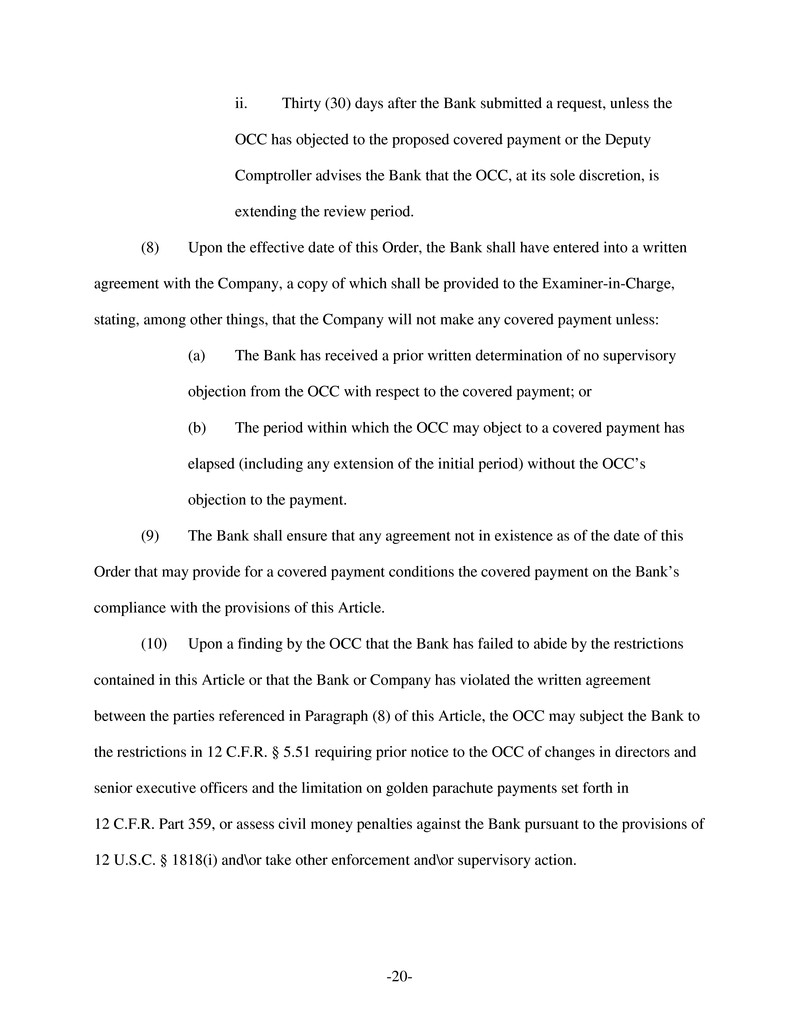
-20- ii. Thirty (30) days after the Bank submitted a request, unless the OCC has objected to the proposed covered payment or the Deputy Comptroller advises the Bank that the OCC, at its sole discretion, is extending the review period. (8) Upon the effective date of this Order, the Bank shall have entered into a written agreement with the Company, a copy of which shall be provided to the Examiner-in-Charge, stating, among other things, that the Company will not make any covered payment unless: (a) The Bank has received a prior written determination of no supervisory objection from the OCC with respect to the covered payment; or (b) The period within which the OCC may object to a covered payment has elapsed (including any extension of the initial period) without the OCC’s objection to the payment. (9) The Bank shall ensure that any agreement not in existence as of the date of this Order that may provide for a covered payment conditions the covered payment on the Bank’s compliance with the provisions of this Article. (10) Upon a finding by the OCC that the Bank has failed to abide by the restrictions contained in this Article or that the Bank or Company has violated the written agreement between the parties referenced in Paragraph (8) of this Article, the OCC may subject the Bank to the restrictions in 12 C.F.R. § 5.51 requiring prior notice to the OCC of changes in directors and senior executive officers and the limitation on golden parachute payments set forth in 12 C.F.R. Part 359, or assess civil money penalties against the Bank pursuant to the provisions of 12 U.S.C. § 1818(i) and\or take other enforcement and\or supervisory action.
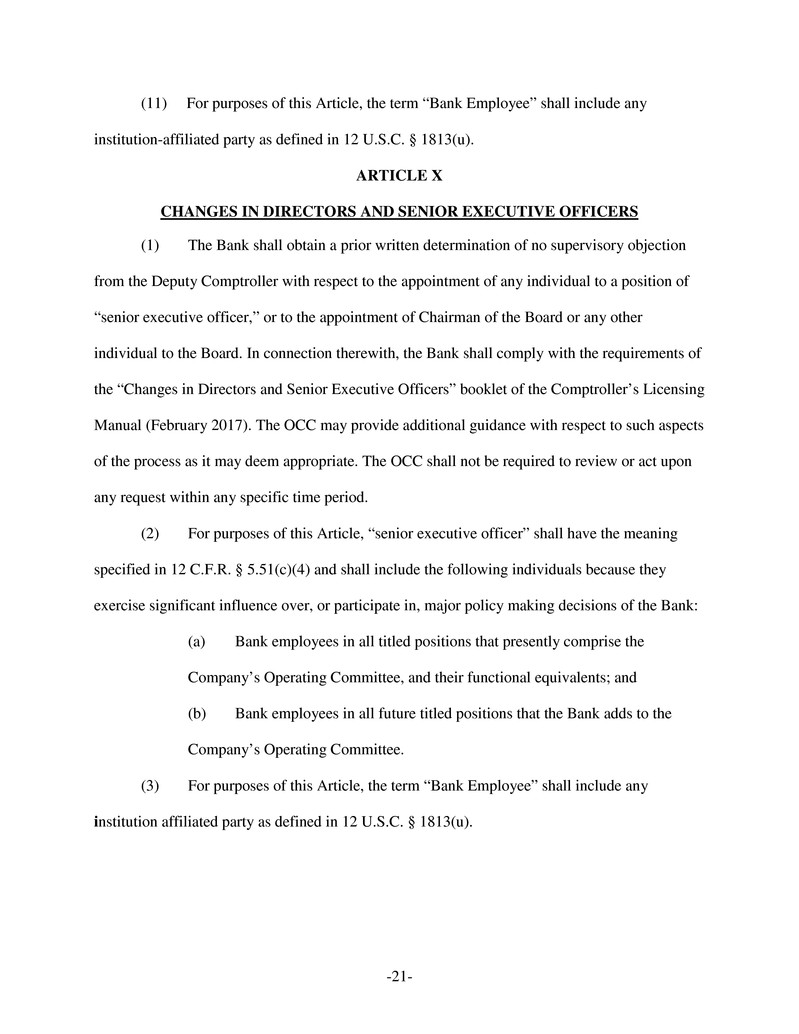
-21- (11) For purposes of this Article, the term “Bank Employee” shall include any institution-affiliated party as defined in 12 U.S.C. § 1813(u). ARTICLE X CHANGES IN DIRECTORS AND SENIOR EXECUTIVE OFFICERS (1) The Bank shall obtain a prior written determination of no supervisory objection from the Deputy Comptroller with respect to the appointment of any individual to a position of “senior executive officer,” or to the appointment of Chairman of the Board or any other individual to the Board. In connection therewith, the Bank shall comply with the requirements of the “Changes in Directors and Senior Executive Officers” booklet of the Comptroller’s Licensing Manual (February 2017). The OCC may provide additional guidance with respect to such aspects of the process as it may deem appropriate. The OCC shall not be required to review or act upon any request within any specific time period. (2) For purposes of this Article, “senior executive officer” shall have the meaning specified in 12 C.F.R. § 5.51(c)(4) and shall include the following individuals because they exercise significant influence over, or participate in, major policy making decisions of the Bank: (a) Bank employees in all titled positions that presently comprise the Company’s Operating Committee, and their functional equivalents; and (b) Bank employees in all future titled positions that the Bank adds to the Company’s Operating Committee. (3) For purposes of this Article, the term “Bank Employee” shall include any institution affiliated party as defined in 12 U.S.C. § 1813(u).
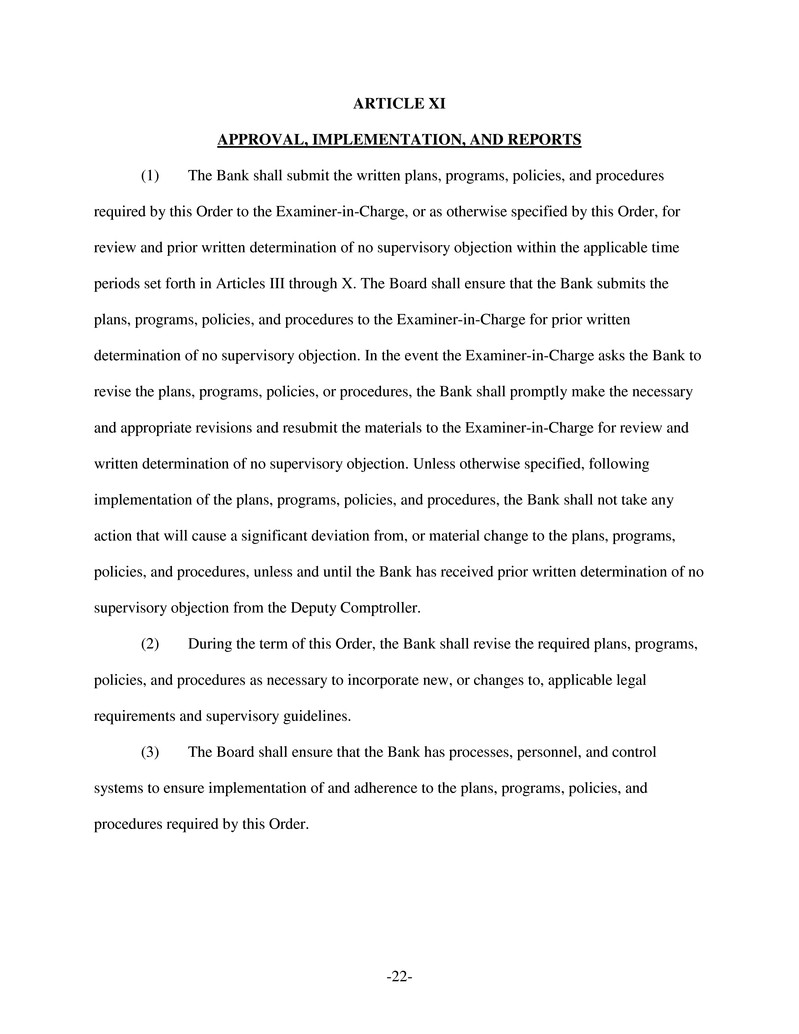
-22- ARTICLE XI APPROVAL, IMPLEMENTATION, AND REPORTS (1) The Bank shall submit the written plans, programs, policies, and procedures required by this Order to the Examiner-in-Charge, or as otherwise specified by this Order, for review and prior written determination of no supervisory objection within the applicable time periods set forth in Articles III through X. The Board shall ensure that the Bank submits the plans, programs, policies, and procedures to the Examiner-in-Charge for prior written determination of no supervisory objection. In the event the Examiner-in-Charge asks the Bank to revise the plans, programs, policies, or procedures, the Bank shall promptly make the necessary and appropriate revisions and resubmit the materials to the Examiner-in-Charge for review and written determination of no supervisory objection. Unless otherwise specified, following implementation of the plans, programs, policies, and procedures, the Bank shall not take any action that will cause a significant deviation from, or material change to the plans, programs, policies, and procedures, unless and until the Bank has received prior written determination of no supervisory objection from the Deputy Comptroller. (2) During the term of this Order, the Bank shall revise the required plans, programs, policies, and procedures as necessary to incorporate new, or changes to, applicable legal requirements and supervisory guidelines. (3) The Board shall ensure that the Bank has processes, personnel, and control systems to ensure implementation of and adherence to the plans, programs, policies, and procedures required by this Order.
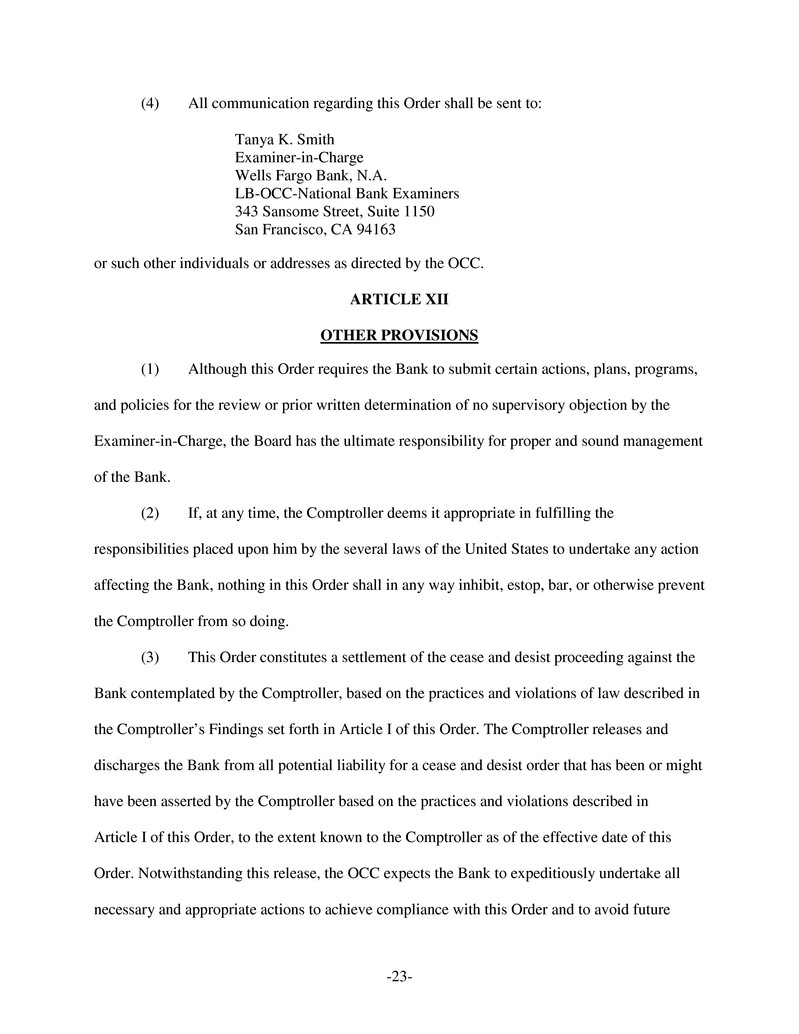
-23- (4) All communication regarding this Order shall be sent to: Tanya K. Smith Examiner-in-Charge Wells Fargo Bank, N.A. LB-OCC-National Bank Examiners 343 Sansome Street, Suite 1150 San Francisco, CA 94163 or such other individuals or addresses as directed by the OCC. ARTICLE XII OTHER PROVISIONS (1) Although this Order requires the Bank to submit certain actions, plans, programs, and policies for the review or prior written determination of no supervisory objection by the Examiner-in-Charge, the Board has the ultimate responsibility for proper and sound management of the Bank. (2) If, at any time, the Comptroller deems it appropriate in fulfilling the responsibilities placed upon him by the several laws of the United States to undertake any action affecting the Bank, nothing in this Order shall in any way inhibit, estop, bar, or otherwise prevent the Comptroller from so doing. (3) This Order constitutes a settlement of the cease and desist proceeding against the Bank contemplated by the Comptroller, based on the practices and violations of law described in the Comptroller’s Findings set forth in Article I of this Order. The Comptroller releases and discharges the Bank from all potential liability for a cease and desist order that has been or might have been asserted by the Comptroller based on the practices and violations described in Article I of this Order, to the extent known to the Comptroller as of the effective date of this Order. Notwithstanding this release, the OCC expects the Bank to expeditiously undertake all necessary and appropriate actions to achieve compliance with this Order and to avoid future
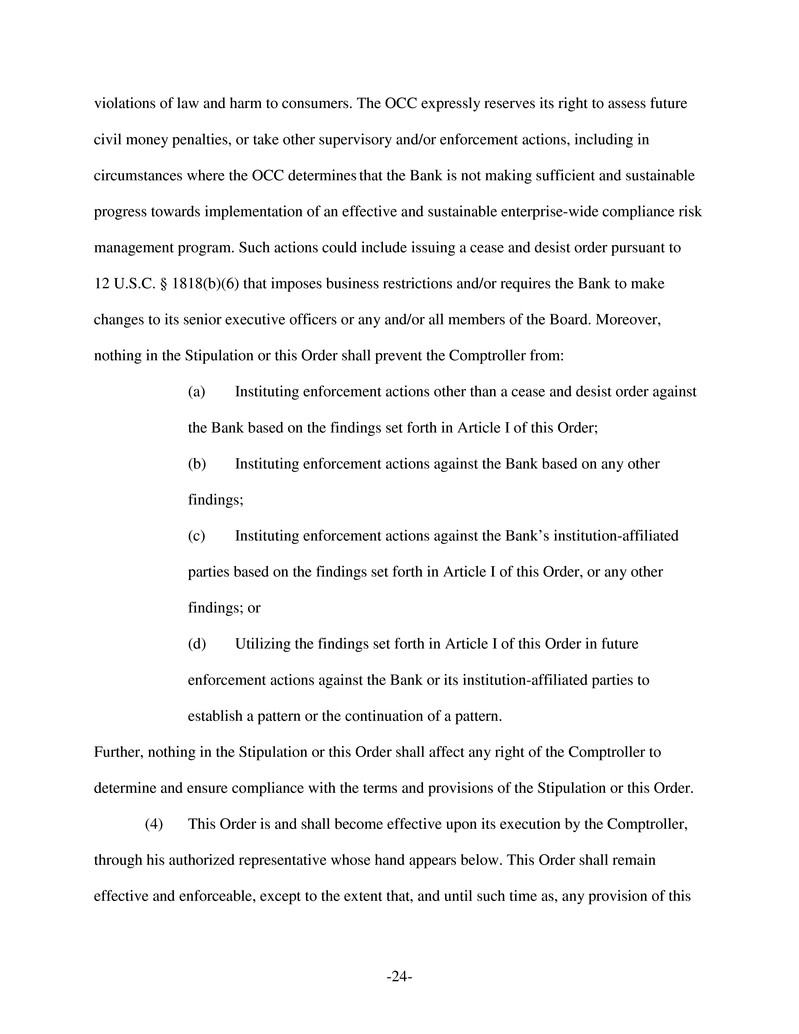
-24- violations of law and harm to consumers. The OCC expressly reserves its right to assess future civil money penalties, or take other supervisory and/or enforcement actions, including in circumstances where the OCC determines that the Bank is not making sufficient and sustainable progress towards implementation of an effective and sustainable enterprise-wide compliance risk management program. Such actions could include issuing a cease and desist order pursuant to 12 U.S.C. § 1818(b)(6) that imposes business restrictions and/or requires the Bank to make changes to its senior executive officers or any and/or all members of the Board. Moreover, nothing in the Stipulation or this Order shall prevent the Comptroller from: (a) Instituting enforcement actions other than a cease and desist order against the Bank based on the findings set forth in Article I of this Order; (b) Instituting enforcement actions against the Bank based on any other findings; (c) Instituting enforcement actions against the Bank’s institution-affiliated parties based on the findings set forth in Article I of this Order, or any other findings; or (d) Utilizing the findings set forth in Article I of this Order in future enforcement actions against the Bank or its institution-affiliated parties to establish a pattern or the continuation of a pattern. Further, nothing in the Stipulation or this Order shall affect any right of the Comptroller to determine and ensure compliance with the terms and provisions of the Stipulation or this Order. (4) This Order is and shall become effective upon its execution by the Comptroller, through his authorized representative whose hand appears below. This Order shall remain effective and enforceable, except to the extent that, and until such time as, any provision of this
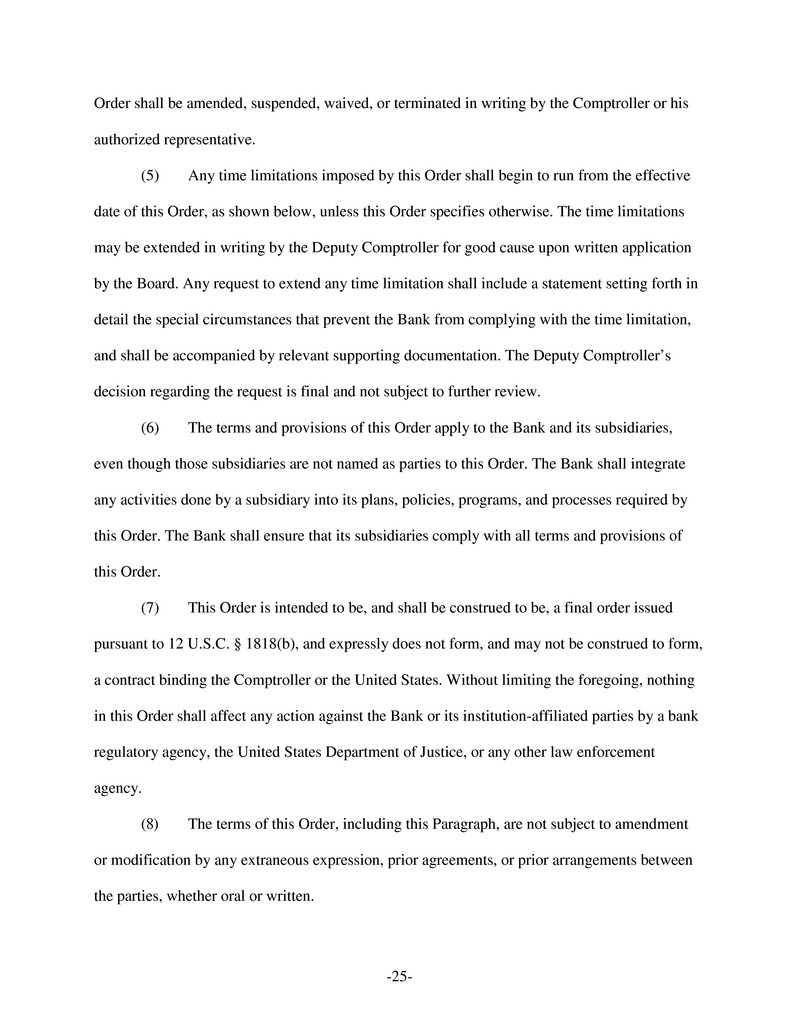
-25- Order shall be amended, suspended, waived, or terminated in writing by the Comptroller or his authorized representative. (5) Any time limitations imposed by this Order shall begin to run from the effective date of this Order, as shown below, unless this Order specifies otherwise. The time limitations may be extended in writing by the Deputy Comptroller for good cause upon written application by the Board. Any request to extend any time limitation shall include a statement setting forth in detail the special circumstances that prevent the Bank from complying with the time limitation, and shall be accompanied by relevant supporting documentation. The Deputy Comptroller’s decision regarding the request is final and not subject to further review. (6) The terms and provisions of this Order apply to the Bank and its subsidiaries, even though those subsidiaries are not named as parties to this Order. The Bank shall integrate any activities done by a subsidiary into its plans, policies, programs, and processes required by this Order. The Bank shall ensure that its subsidiaries comply with all terms and provisions of this Order. (7) This Order is intended to be, and shall be construed to be, a final order issued pursuant to 12 U.S.C. § 1818(b), and expressly does not form, and may not be construed to form, a contract binding the Comptroller or the United States. Without limiting the foregoing, nothing in this Order shall affect any action against the Bank or its institution-affiliated parties by a bank regulatory agency, the United States Department of Justice, or any other law enforcement agency. (8) The terms of this Order, including this Paragraph, are not subject to amendment or modification by any extraneous expression, prior agreements, or prior arrangements between the parties, whether oral or written.
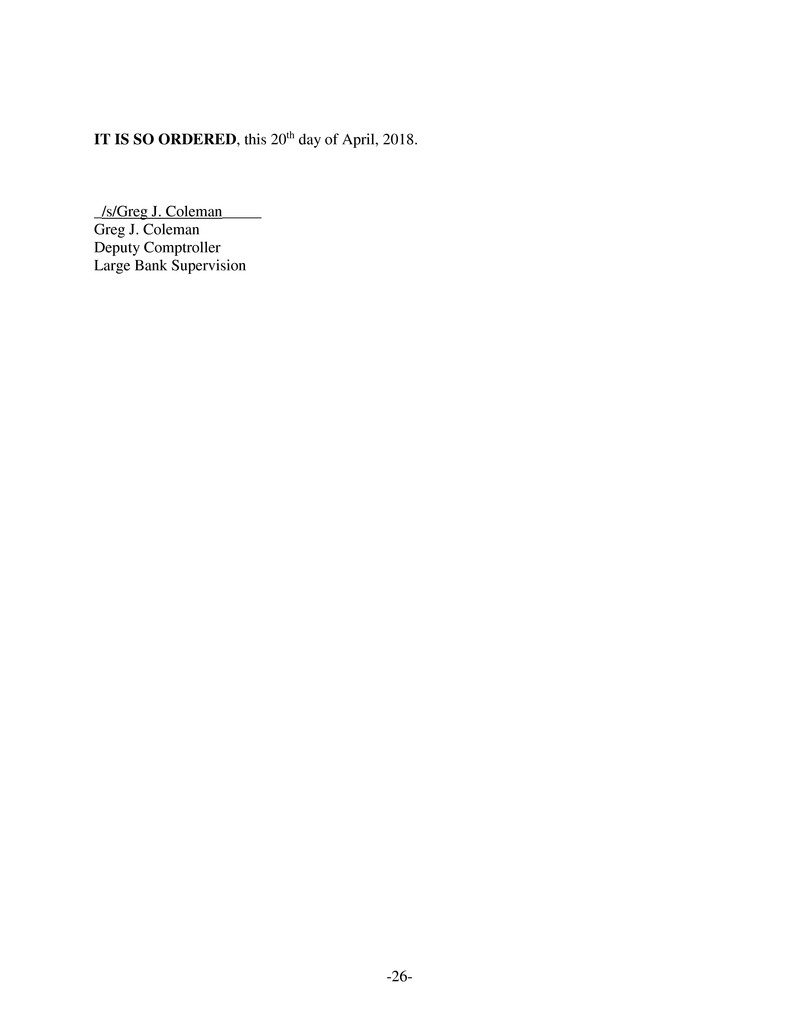
-26- IT IS SO ORDERED, this 20th day of April, 2018. _/s/Greg J. Coleman_____ Greg J. Coleman Deputy Comptroller Large Bank Supervision
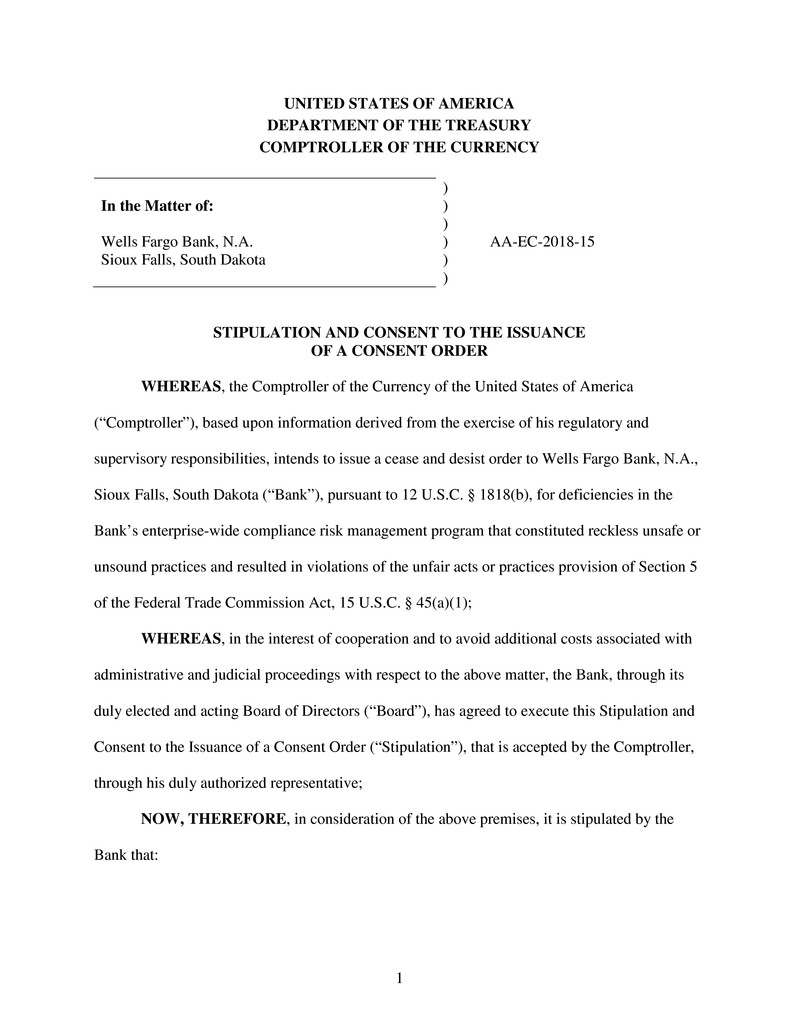
1 UNITED STATES OF AMERICA DEPARTMENT OF THE TREASURY COMPTROLLER OF THE CURRENCY In the Matter of: Wells Fargo Bank, N.A. Sioux Falls, South Dakota ) ) ) ) ) ) AA-EC-2018-15 STIPULATION AND CONSENT TO THE ISSUANCE OF A CONSENT ORDER WHEREAS, the Comptroller of the Currency of the United States of America (“Comptroller”), based upon information derived from the exercise of his regulatory and supervisory responsibilities, intends to issue a cease and desist order to Wells Fargo Bank, N.A., Sioux Falls, South Dakota (“Bank”), pursuant to 12 U.S.C. § 1818(b), for deficiencies in the Bank’s enterprise-wide compliance risk management program that constituted reckless unsafe or unsound practices and resulted in violations of the unfair acts or practices provision of Section 5 of the Federal Trade Commission Act, 15 U.S.C. § 45(a)(1); WHEREAS, in the interest of cooperation and to avoid additional costs associated with administrative and judicial proceedings with respect to the above matter, the Bank, through its duly elected and acting Board of Directors (“Board”), has agreed to execute this Stipulation and Consent to the Issuance of a Consent Order (“Stipulation”), that is accepted by the Comptroller, through his duly authorized representative; NOW, THEREFORE, in consideration of the above premises, it is stipulated by the Bank that:
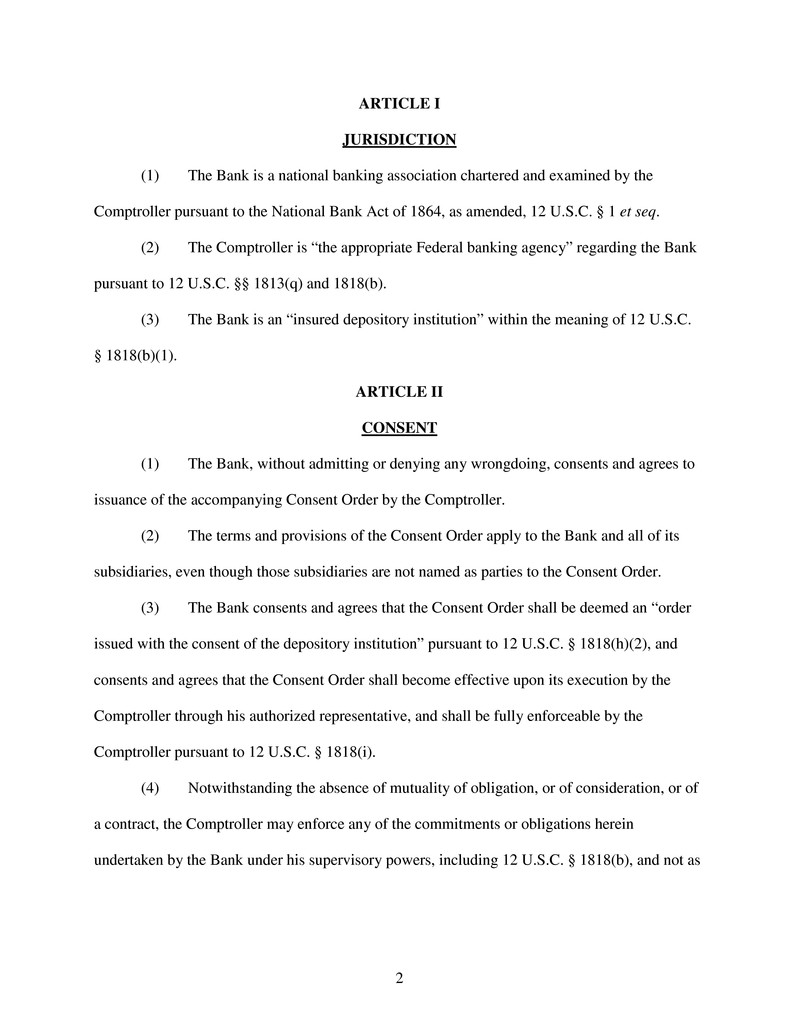
2 ARTICLE I JURISDICTION (1) The Bank is a national banking association chartered and examined by the Comptroller pursuant to the National Bank Act of 1864, as amended, 12 U.S.C. § 1 et seq. (2) The Comptroller is “the appropriate Federal banking agency” regarding the Bank pursuant to 12 U.S.C. §§ 1813(q) and 1818(b). (3) The Bank is an “insured depository institution” within the meaning of 12 U.S.C. § 1818(b)(1). ARTICLE II CONSENT (1) The Bank, without admitting or denying any wrongdoing, consents and agrees to issuance of the accompanying Consent Order by the Comptroller. (2) The terms and provisions of the Consent Order apply to the Bank and all of its subsidiaries, even though those subsidiaries are not named as parties to the Consent Order. (3) The Bank consents and agrees that the Consent Order shall be deemed an “order issued with the consent of the depository institution” pursuant to 12 U.S.C. § 1818(h)(2), and consents and agrees that the Consent Order shall become effective upon its execution by the Comptroller through his authorized representative, and shall be fully enforceable by the Comptroller pursuant to 12 U.S.C. § 1818(i). (4) Notwithstanding the absence of mutuality of obligation, or of consideration, or of a contract, the Comptroller may enforce any of the commitments or obligations herein undertaken by the Bank under his supervisory powers, including 12 U.S.C. § 1818(b), and not as
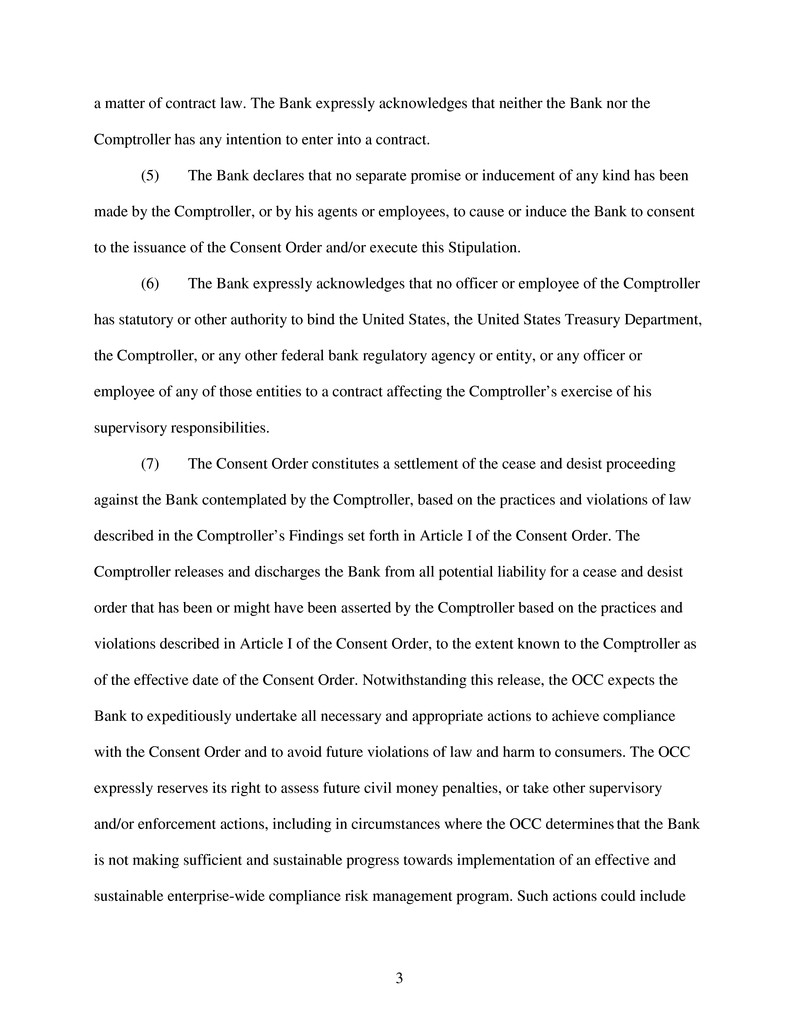
3 a matter of contract law. The Bank expressly acknowledges that neither the Bank nor the Comptroller has any intention to enter into a contract. (5) The Bank declares that no separate promise or inducement of any kind has been made by the Comptroller, or by his agents or employees, to cause or induce the Bank to consent to the issuance of the Consent Order and/or execute this Stipulation. (6) The Bank expressly acknowledges that no officer or employee of the Comptroller has statutory or other authority to bind the United States, the United States Treasury Department, the Comptroller, or any other federal bank regulatory agency or entity, or any officer or employee of any of those entities to a contract affecting the Comptroller’s exercise of his supervisory responsibilities. (7) The Consent Order constitutes a settlement of the cease and desist proceeding against the Bank contemplated by the Comptroller, based on the practices and violations of law described in the Comptroller’s Findings set forth in Article I of the Consent Order. The Comptroller releases and discharges the Bank from all potential liability for a cease and desist order that has been or might have been asserted by the Comptroller based on the practices and violations described in Article I of the Consent Order, to the extent known to the Comptroller as of the effective date of the Consent Order. Notwithstanding this release, the OCC expects the Bank to expeditiously undertake all necessary and appropriate actions to achieve compliance with the Consent Order and to avoid future violations of law and harm to consumers. The OCC expressly reserves its right to assess future civil money penalties, or take other supervisory and/or enforcement actions, including in circumstances where the OCC determines that the Bank is not making sufficient and sustainable progress towards implementation of an effective and sustainable enterprise-wide compliance risk management program. Such actions could include
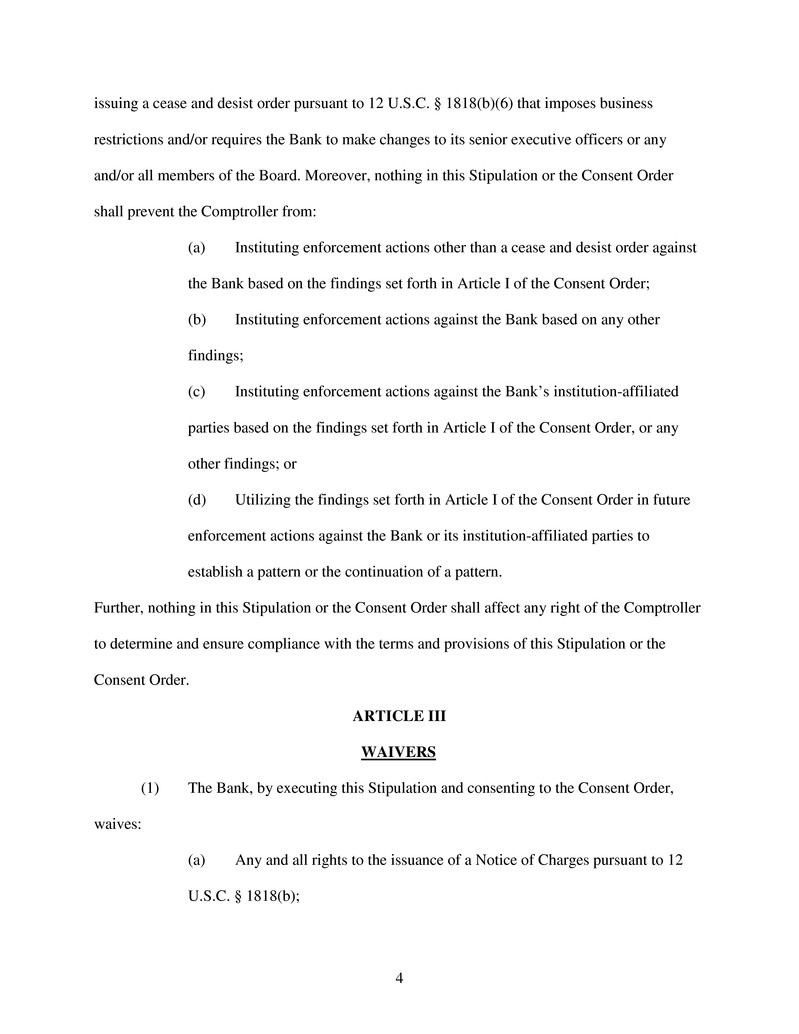
4 issuing a cease and desist order pursuant to 12 U.S.C. § 1818(b)(6) that imposes business restrictions and/or requires the Bank to make changes to its senior executive officers or any and/or all members of the Board. Moreover, nothing in this Stipulation or the Consent Order shall prevent the Comptroller from: (a) Instituting enforcement actions other than a cease and desist order against the Bank based on the findings set forth in Article I of the Consent Order; (b) Instituting enforcement actions against the Bank based on any other findings; (c) Instituting enforcement actions against the Bank’s institution-affiliated parties based on the findings set forth in Article I of the Consent Order, or any other findings; or (d) Utilizing the findings set forth in Article I of the Consent Order in future enforcement actions against the Bank or its institution-affiliated parties to establish a pattern or the continuation of a pattern. Further, nothing in this Stipulation or the Consent Order shall affect any right of the Comptroller to determine and ensure compliance with the terms and provisions of this Stipulation or the Consent Order. ARTICLE III WAIVERS (1) The Bank, by executing this Stipulation and consenting to the Consent Order, waives: (a) Any and all rights to the issuance of a Notice of Charges pursuant to 12 U.S.C. § 1818(b);
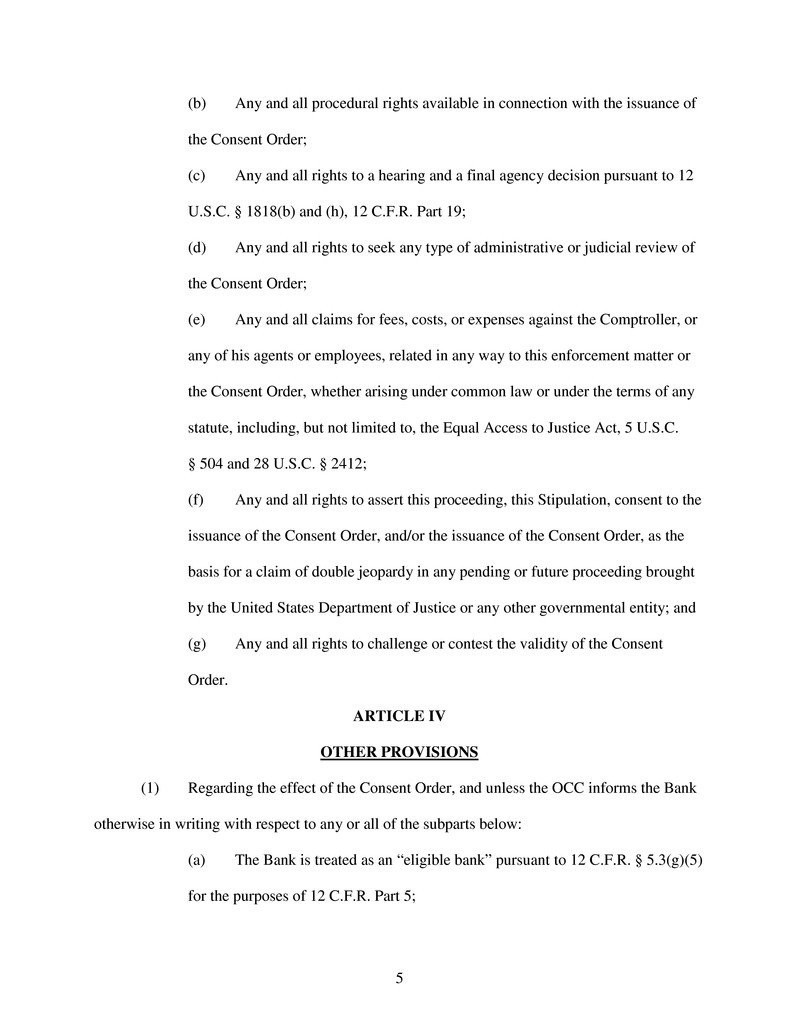
5 (b) Any and all procedural rights available in connection with the issuance of the Consent Order; (c) Any and all rights to a hearing and a final agency decision pursuant to 12 U.S.C. § 1818(b) and (h), 12 C.F.R. Part 19; (d) Any and all rights to seek any type of administrative or judicial review of the Consent Order; (e) Any and all claims for fees, costs, or expenses against the Comptroller, or any of his agents or employees, related in any way to this enforcement matter or the Consent Order, whether arising under common law or under the terms of any statute, including, but not limited to, the Equal Access to Justice Act, 5 U.S.C. § 504 and 28 U.S.C. § 2412; (f) Any and all rights to assert this proceeding, this Stipulation, consent to the issuance of the Consent Order, and/or the issuance of the Consent Order, as the basis for a claim of double jeopardy in any pending or future proceeding brought by the United States Department of Justice or any other governmental entity; and (g) Any and all rights to challenge or contest the validity of the Consent Order. ARTICLE IV OTHER PROVISIONS (1) Regarding the effect of the Consent Order, and unless the OCC informs the Bank otherwise in writing with respect to any or all of the subparts below: (a) The Bank is treated as an “eligible bank” pursuant to 12 C.F.R. § 5.3(g)(5) for the purposes of 12 C.F.R. Part 5;

6 (b) The Bank is not subject to the restrictions in 12 C.F.R. § 5.51 requiring prior notice to the OCC of changes in directors and senior executive officers or the limitation on golden parachute payments set forth in 12 C.F.R. Part 359, but is subject to the restrictions of Articles IX and X of the Consent Order; and (c) The Bank is treated as an “eligible bank” pursuant to 12 C.F.R. § 24.2(e)(4) for the purposes of 12 C.F.R. Part 24 regarding community and economic development. (2) Notwithstanding Paragraph (1) of this Article, the Bank’s status under 12 C.F.R. §§ 5.3(g), 24.1(e), and 5.51(c)(7) is contingent upon the Bank’s satisfaction of the requirements of 12 C.F.R. §§ 5.3(g)(1)-(4), 24(e)(1)-(3), and 5.51(c)(7)(i), (iii). (3) The Stipulation supersedes all prior OCC communications informing the Bank whether it will be treated as an “eligible bank” for the purposes of 12 C.F.R. Parts 5 and 24 as a result of an enforcement action. ARTICLE V CLOSING (1) The provisions of this Stipulation and the Consent Order shall not inhibit, estop, bar, or otherwise prevent the Comptroller from taking any other action affecting the Bank if, at any time, he deems it appropriate to do so to fulfill the responsibilities placed upon him by the several laws of the United States of America. (2) Nothing in this Stipulation or the Consent Order shall preclude any proceedings brought by the Comptroller to enforce the terms of the Consent Order, and nothing in this Stipulation or the Consent Order constitutes, nor shall the Bank contend that it constitutes, a release, discharge, compromise, settlement, dismissal, or resolution of any actions, or in any way
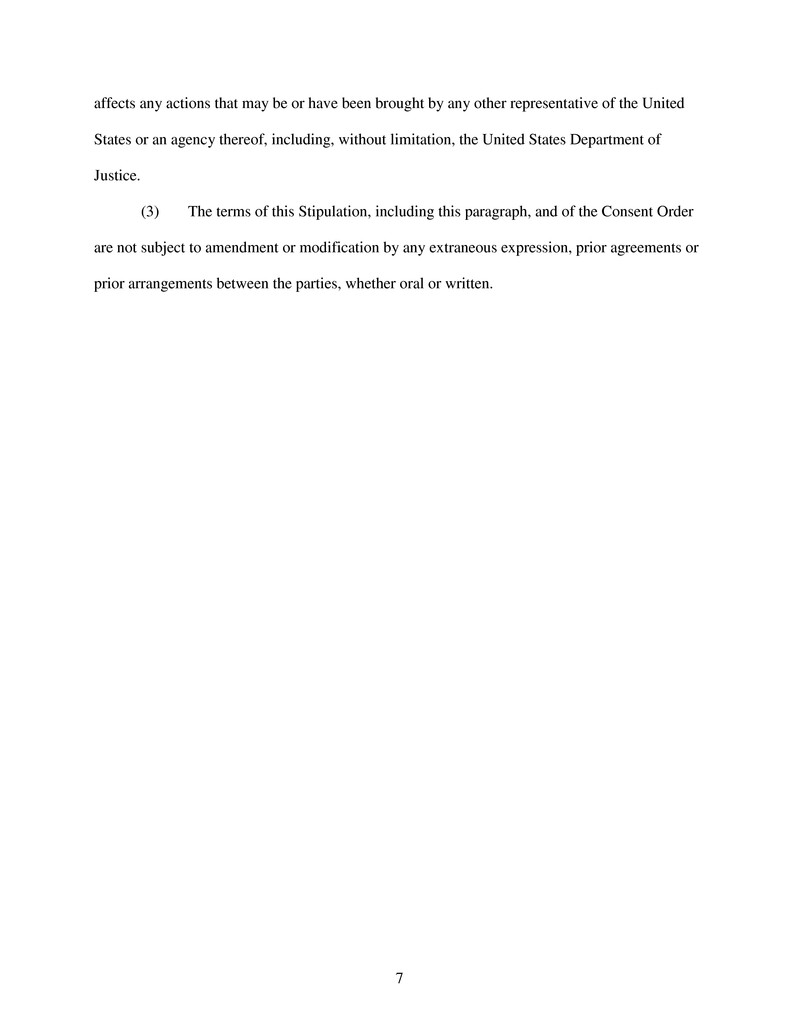
7 affects any actions that may be or have been brought by any other representative of the United States or an agency thereof, including, without limitation, the United States Department of Justice. (3) The terms of this Stipulation, including this paragraph, and of the Consent Order are not subject to amendment or modification by any extraneous expression, prior agreements or prior arrangements between the parties, whether oral or written.
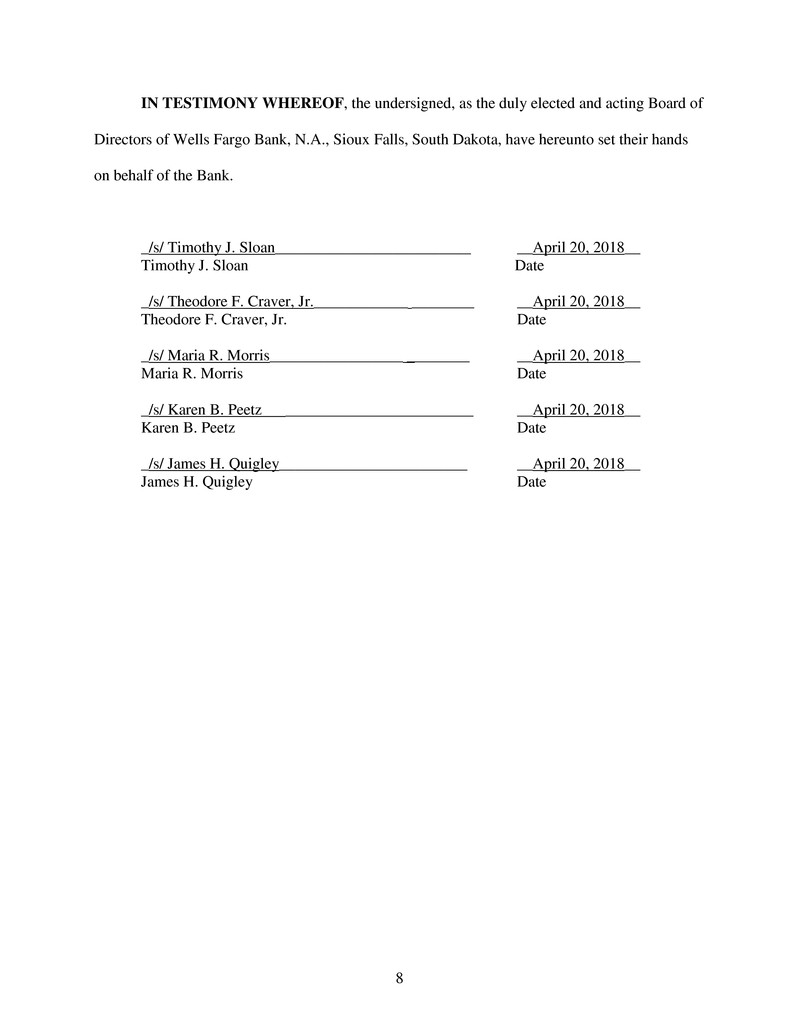
8 IN TESTIMONY WHEREOF, the undersigned, as the duly elected and acting Board of Directors of Wells Fargo Bank, N.A., Sioux Falls, South Dakota, have hereunto set their hands on behalf of the Bank. _/s/ Timothy J. Sloan_________________________ Timothy J. Sloan _/s/ Theodore F. Craver, Jr.____________ ________ Theodore F. Craver, Jr. _/s/ Maria R. Morris_________________ ________ Maria R. Morris _/s/ Karen B. Peetz ________________________ Karen B. Peetz _/s/ James H. Quigley________________________ James H. Quigley __April 20, 2018__ Date __April 20, 2018__ Date __April 20, 2018__ Date __April 20, 2018__ Date __April 20, 2018__ Date
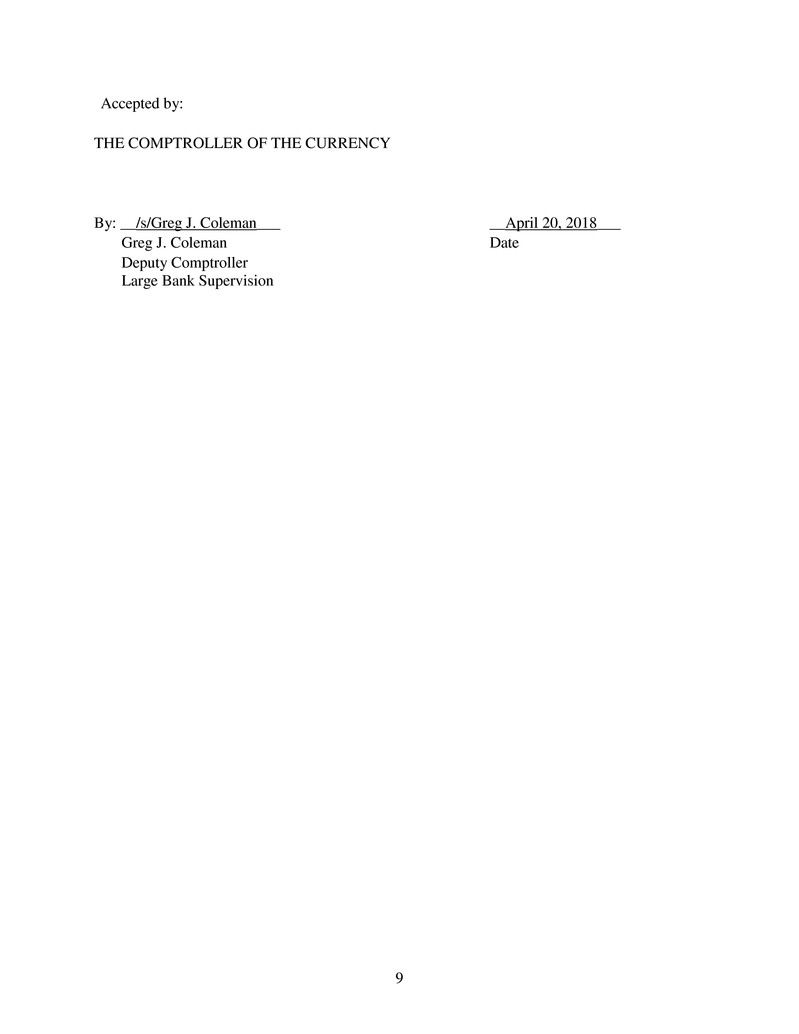
9 Accepted by: THE COMPTROLLER OF THE CURRENCY By: __/s/Greg J. Coleman___ __April 20, 2018___ Greg J. Coleman Date Deputy Comptroller Large Bank Supervision
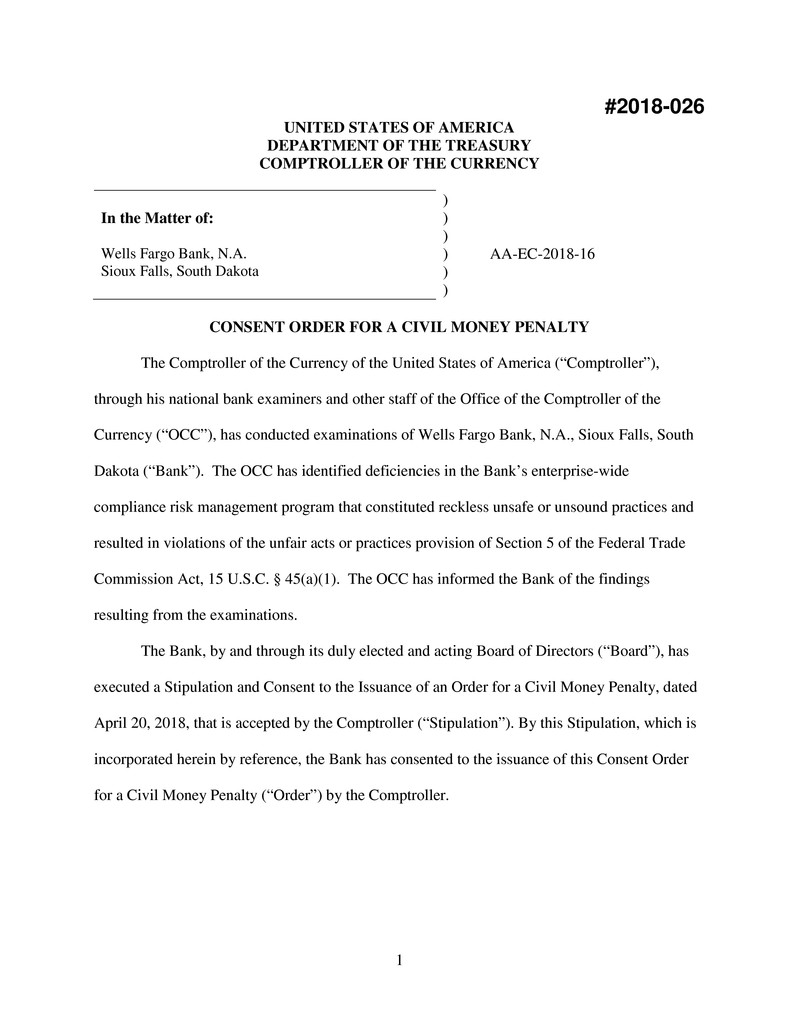
1 #2018-026 UNITED STATES OF AMERICA DEPARTMENT OF THE TREASURY COMPTROLLER OF THE CURRENCY In the Matter of: Wells Fargo Bank, N.A. Sioux Falls, South Dakota ) ) ) ) ) ) AA-EC-2018-16 CONSENT ORDER FOR A CIVIL MONEY PENALTY The Comptroller of the Currency of the United States of America (“Comptroller”), through his national bank examiners and other staff of the Office of the Comptroller of the Currency (“OCC”), has conducted examinations of Wells Fargo Bank, N.A., Sioux Falls, South Dakota (“Bank”). The OCC has identified deficiencies in the Bank’s enterprise-wide compliance risk management program that constituted reckless unsafe or unsound practices and resulted in violations of the unfair acts or practices provision of Section 5 of the Federal Trade Commission Act, 15 U.S.C. § 45(a)(1). The OCC has informed the Bank of the findings resulting from the examinations. The Bank, by and through its duly elected and acting Board of Directors (“Board”), has executed a Stipulation and Consent to the Issuance of an Order for a Civil Money Penalty, dated April 20, 2018, that is accepted by the Comptroller (“Stipulation”). By this Stipulation, which is incorporated herein by reference, the Bank has consented to the issuance of this Consent Order for a Civil Money Penalty (“Order”) by the Comptroller.
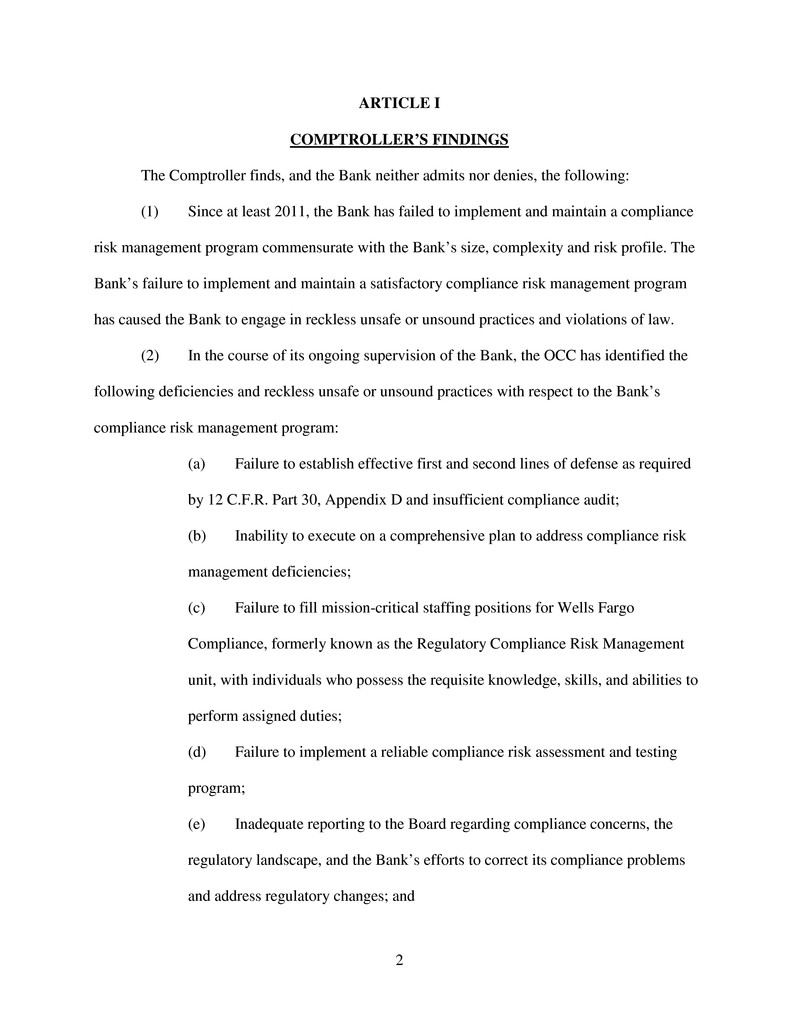
2 ARTICLE I COMPTROLLER’S FINDINGS The Comptroller finds, and the Bank neither admits nor denies, the following: (1) Since at least 2011, the Bank has failed to implement and maintain a compliance risk management program commensurate with the Bank’s size, complexity and risk profile. The Bank’s failure to implement and maintain a satisfactory compliance risk management program has caused the Bank to engage in reckless unsafe or unsound practices and violations of law. (2) In the course of its ongoing supervision of the Bank, the OCC has identified the following deficiencies and reckless unsafe or unsound practices with respect to the Bank’s compliance risk management program: (a) Failure to establish effective first and second lines of defense as required by 12 C.F.R. Part 30, Appendix D and insufficient compliance audit; (b) Inability to execute on a comprehensive plan to address compliance risk management deficiencies; (c) Failure to fill mission-critical staffing positions for Wells Fargo Compliance, formerly known as the Regulatory Compliance Risk Management unit, with individuals who possess the requisite knowledge, skills, and abilities to perform assigned duties; (d) Failure to implement a reliable compliance risk assessment and testing program; (e) Inadequate reporting to the Board regarding compliance concerns, the regulatory landscape, and the Bank’s efforts to correct its compliance problems and address regulatory changes; and
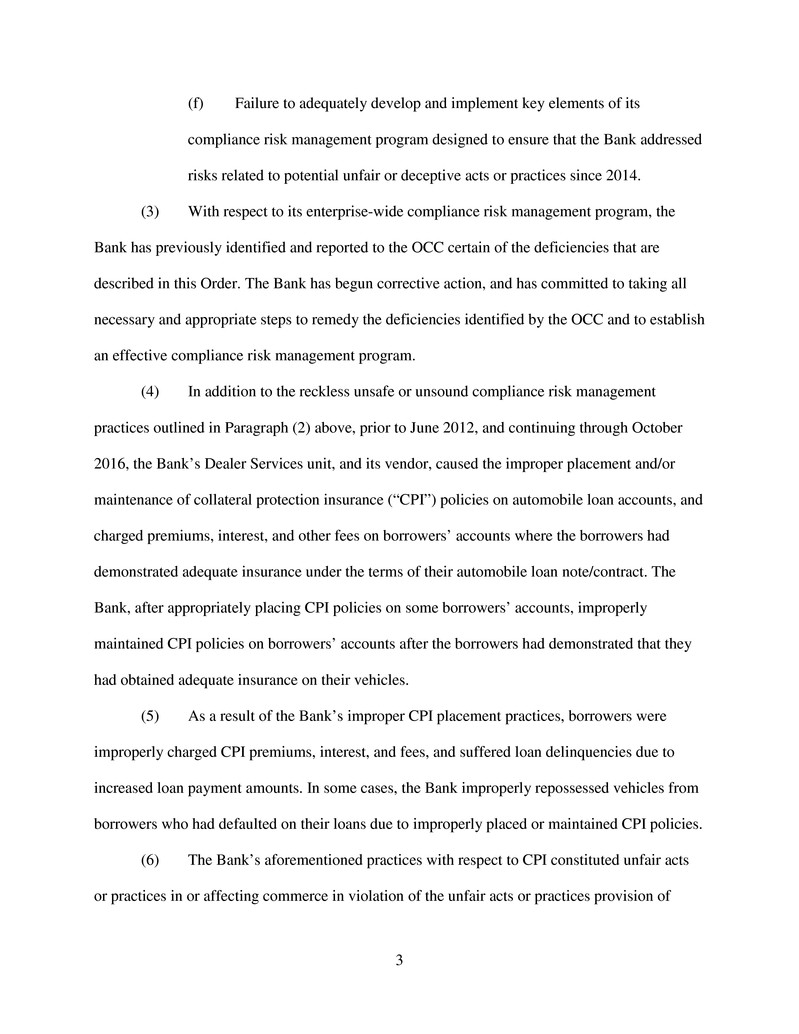
3 (f) Failure to adequately develop and implement key elements of its compliance risk management program designed to ensure that the Bank addressed risks related to potential unfair or deceptive acts or practices since 2014. (3) With respect to its enterprise-wide compliance risk management program, the Bank has previously identified and reported to the OCC certain of the deficiencies that are described in this Order. The Bank has begun corrective action, and has committed to taking all necessary and appropriate steps to remedy the deficiencies identified by the OCC and to establish an effective compliance risk management program. (4) In addition to the reckless unsafe or unsound compliance risk management practices outlined in Paragraph (2) above, prior to June 2012, and continuing through October 2016, the Bank’s Dealer Services unit, and its vendor, caused the improper placement and/or maintenance of collateral protection insurance (“CPI”) policies on automobile loan accounts, and charged premiums, interest, and other fees on borrowers’ accounts where the borrowers had demonstrated adequate insurance under the terms of their automobile loan note/contract. The Bank, after appropriately placing CPI policies on some borrowers’ accounts, improperly maintained CPI policies on borrowers’ accounts after the borrowers had demonstrated that they had obtained adequate insurance on their vehicles. (5) As a result of the Bank’s improper CPI placement practices, borrowers were improperly charged CPI premiums, interest, and fees, and suffered loan delinquencies due to increased loan payment amounts. In some cases, the Bank improperly repossessed vehicles from borrowers who had defaulted on their loans due to improperly placed or maintained CPI policies. (6) The Bank’s aforementioned practices with respect to CPI constituted unfair acts or practices in or affecting commerce in violation of the unfair acts or practices provision of
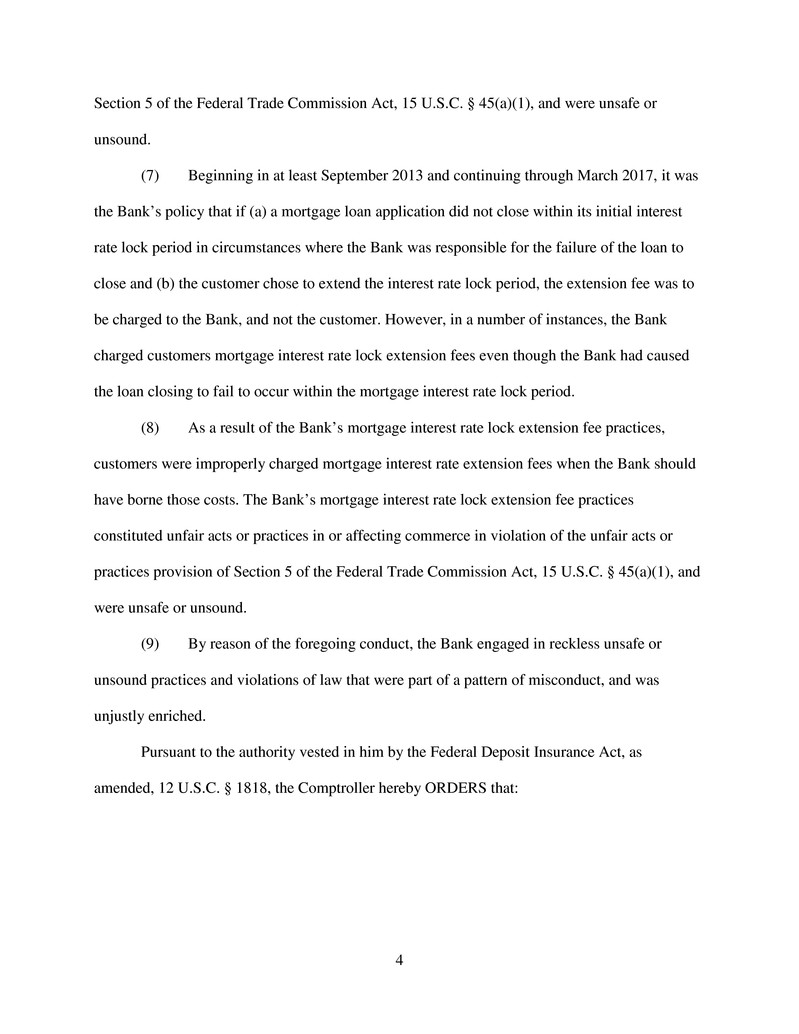
4 Section 5 of the Federal Trade Commission Act, 15 U.S.C. § 45(a)(1), and were unsafe or unsound. (7) Beginning in at least September 2013 and continuing through March 2017, it was the Bank’s policy that if (a) a mortgage loan application did not close within its initial interest rate lock period in circumstances where the Bank was responsible for the failure of the loan to close and (b) the customer chose to extend the interest rate lock period, the extension fee was to be charged to the Bank, and not the customer. However, in a number of instances, the Bank charged customers mortgage interest rate lock extension fees even though the Bank had caused the loan closing to fail to occur within the mortgage interest rate lock period. (8) As a result of the Bank’s mortgage interest rate lock extension fee practices, customers were improperly charged mortgage interest rate extension fees when the Bank should have borne those costs. The Bank’s mortgage interest rate lock extension fee practices constituted unfair acts or practices in or affecting commerce in violation of the unfair acts or practices provision of Section 5 of the Federal Trade Commission Act, 15 U.S.C. § 45(a)(1), and were unsafe or unsound. (9) By reason of the foregoing conduct, the Bank engaged in reckless unsafe or unsound practices and violations of law that were part of a pattern of misconduct, and was unjustly enriched. Pursuant to the authority vested in him by the Federal Deposit Insurance Act, as amended, 12 U.S.C. § 1818, the Comptroller hereby ORDERS that:
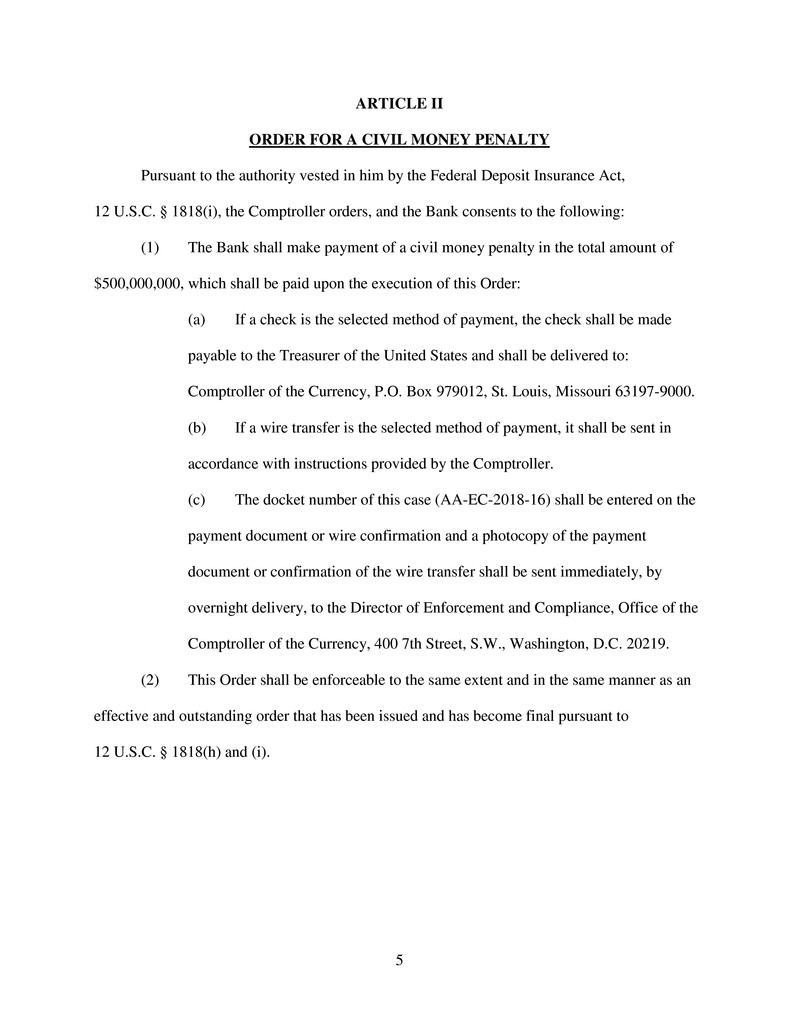
5 ARTICLE II ORDER FOR A CIVIL MONEY PENALTY Pursuant to the authority vested in him by the Federal Deposit Insurance Act, 12 U.S.C. § 1818(i), the Comptroller orders, and the Bank consents to the following: (1) The Bank shall make payment of a civil money penalty in the total amount of $500,000,000, which shall be paid upon the execution of this Order: (a) If a check is the selected method of payment, the check shall be made payable to the Treasurer of the United States and shall be delivered to: Comptroller of the Currency, P.O. Box 979012, St. Louis, Missouri 63197-9000. (b) If a wire transfer is the selected method of payment, it shall be sent in accordance with instructions provided by the Comptroller. (c) The docket number of this case (AA-EC-2018-16) shall be entered on the payment document or wire confirmation and a photocopy of the payment document or confirmation of the wire transfer shall be sent immediately, by overnight delivery, to the Director of Enforcement and Compliance, Office of the Comptroller of the Currency, 400 7th Street, S.W., Washington, D.C. 20219. (2) This Order shall be enforceable to the same extent and in the same manner as an effective and outstanding order that has been issued and has become final pursuant to 12 U.S.C. § 1818(h) and (i).
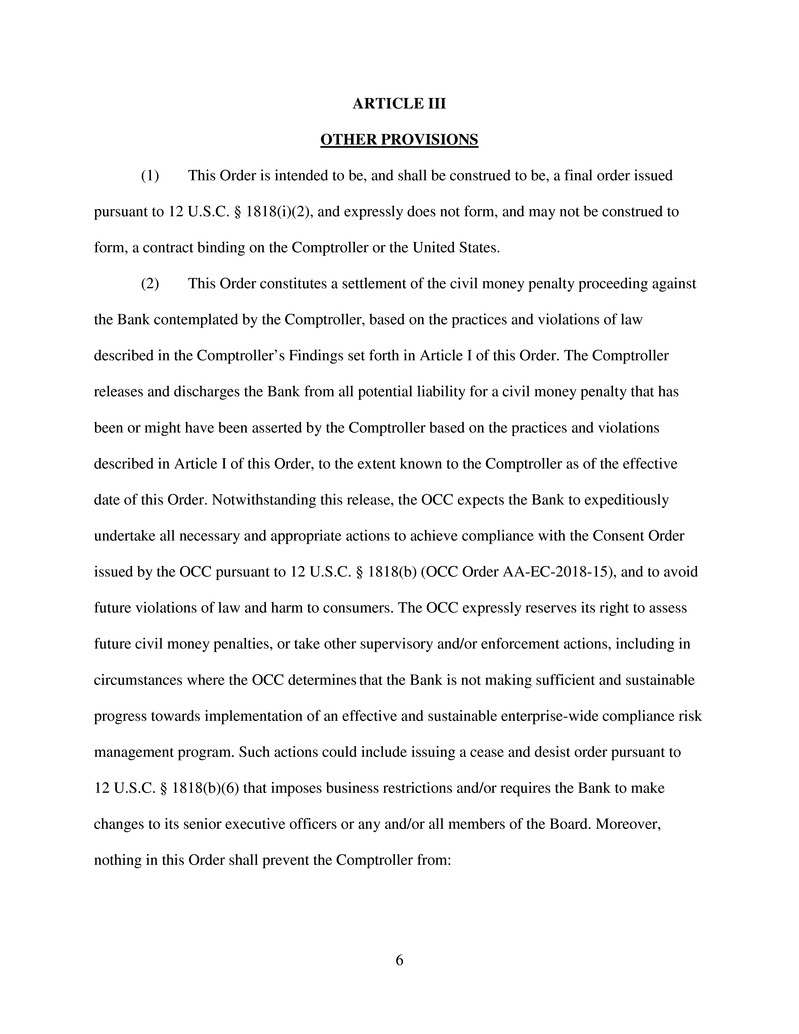
6 ARTICLE III OTHER PROVISIONS (1) This Order is intended to be, and shall be construed to be, a final order issued pursuant to 12 U.S.C. § 1818(i)(2), and expressly does not form, and may not be construed to form, a contract binding on the Comptroller or the United States. (2) This Order constitutes a settlement of the civil money penalty proceeding against the Bank contemplated by the Comptroller, based on the practices and violations of law described in the Comptroller’s Findings set forth in Article I of this Order. The Comptroller releases and discharges the Bank from all potential liability for a civil money penalty that has been or might have been asserted by the Comptroller based on the practices and violations described in Article I of this Order, to the extent known to the Comptroller as of the effective date of this Order. Notwithstanding this release, the OCC expects the Bank to expeditiously undertake all necessary and appropriate actions to achieve compliance with the Consent Order issued by the OCC pursuant to 12 U.S.C. § 1818(b) (OCC Order AA-EC-2018-15), and to avoid future violations of law and harm to consumers. The OCC expressly reserves its right to assess future civil money penalties, or take other supervisory and/or enforcement actions, including in circumstances where the OCC determines that the Bank is not making sufficient and sustainable progress towards implementation of an effective and sustainable enterprise-wide compliance risk management program. Such actions could include issuing a cease and desist order pursuant to 12 U.S.C. § 1818(b)(6) that imposes business restrictions and/or requires the Bank to make changes to its senior executive officers or any and/or all members of the Board. Moreover, nothing in this Order shall prevent the Comptroller from:
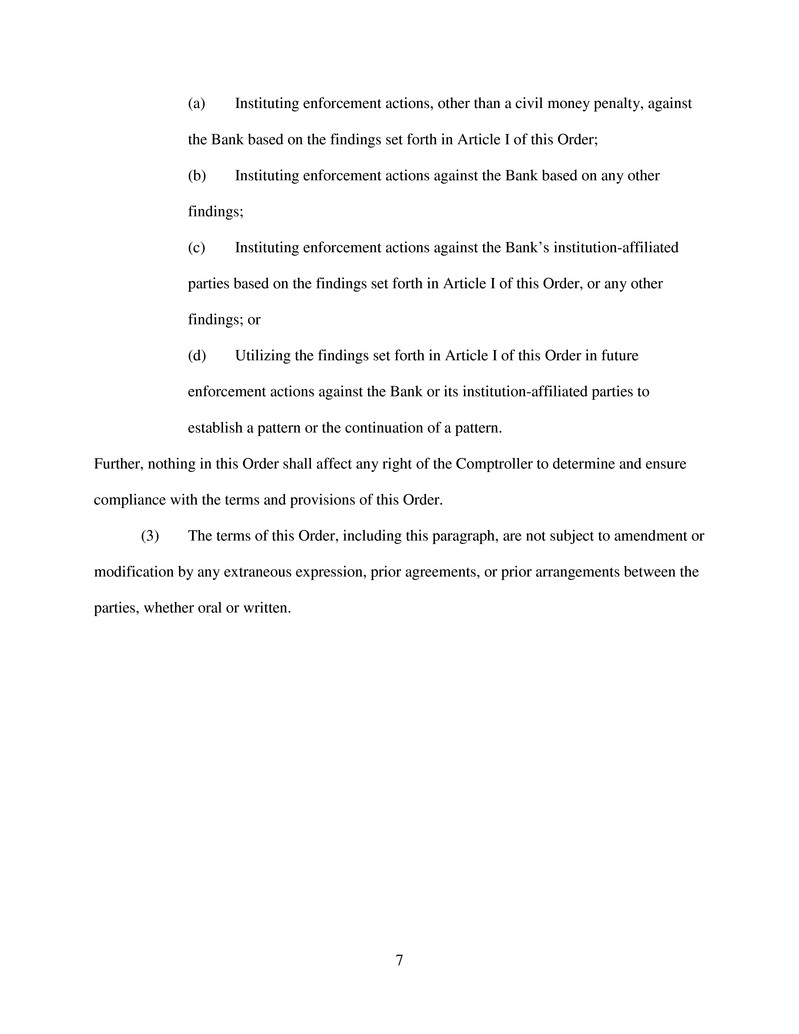
7 (a) Instituting enforcement actions, other than a civil money penalty, against the Bank based on the findings set forth in Article I of this Order; (b) Instituting enforcement actions against the Bank based on any other findings; (c) Instituting enforcement actions against the Bank’s institution-affiliated parties based on the findings set forth in Article I of this Order, or any other findings; or (d) Utilizing the findings set forth in Article I of this Order in future enforcement actions against the Bank or its institution-affiliated parties to establish a pattern or the continuation of a pattern. Further, nothing in this Order shall affect any right of the Comptroller to determine and ensure compliance with the terms and provisions of this Order. (3) The terms of this Order, including this paragraph, are not subject to amendment or modification by any extraneous expression, prior agreements, or prior arrangements between the parties, whether oral or written.
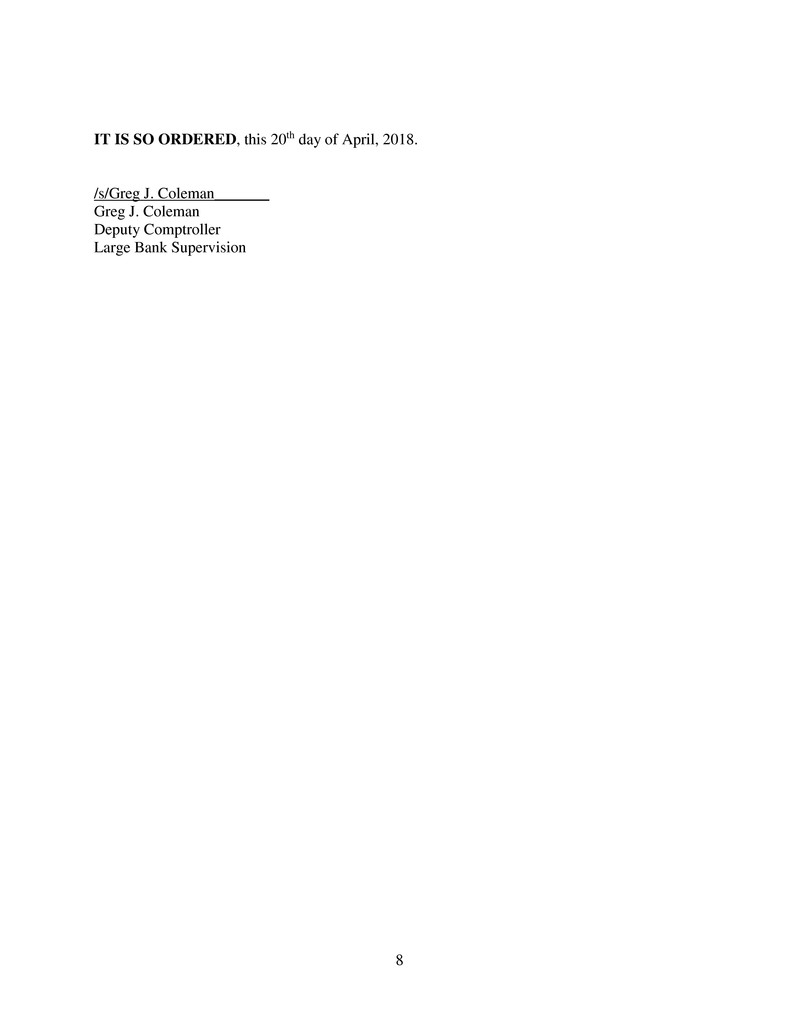
8 IT IS SO ORDERED, this 20th day of April, 2018. /s/Greg J. Coleman_______ Greg J. Coleman Deputy Comptroller Large Bank Supervision
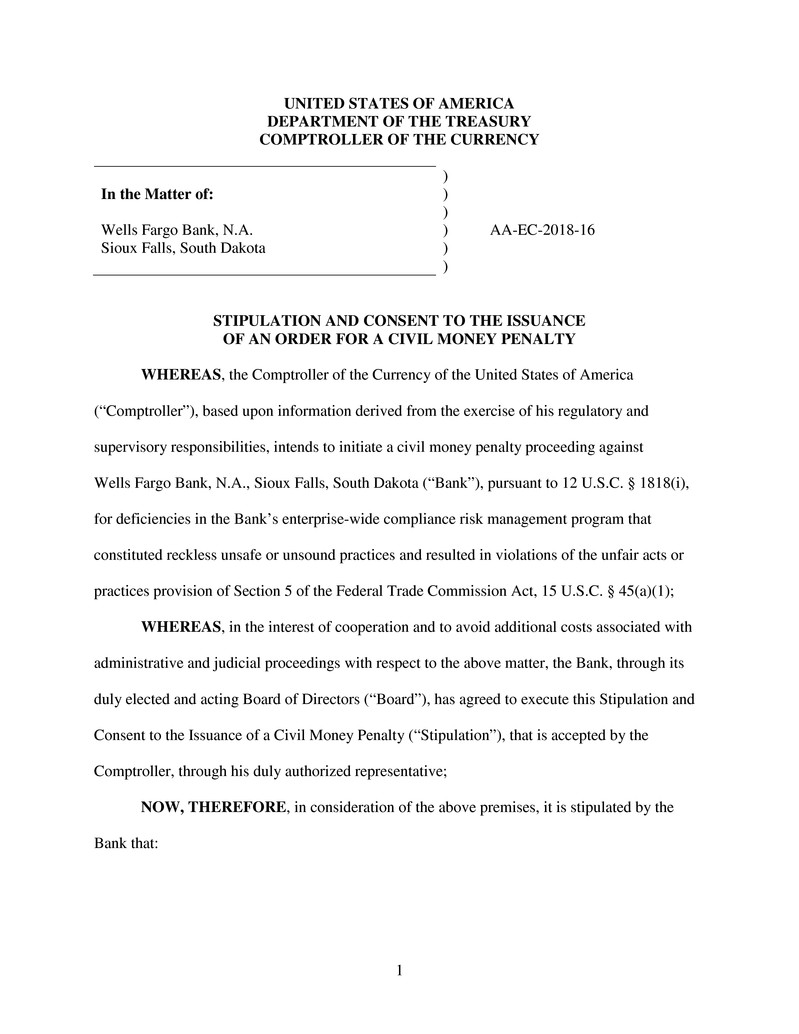
1 UNITED STATES OF AMERICA DEPARTMENT OF THE TREASURY COMPTROLLER OF THE CURRENCY In the Matter of: Wells Fargo Bank, N.A. Sioux Falls, South Dakota ) ) ) ) ) ) AA-EC-2018-16 STIPULATION AND CONSENT TO THE ISSUANCE OF AN ORDER FOR A CIVIL MONEY PENALTY WHEREAS, the Comptroller of the Currency of the United States of America (“Comptroller”), based upon information derived from the exercise of his regulatory and supervisory responsibilities, intends to initiate a civil money penalty proceeding against Wells Fargo Bank, N.A., Sioux Falls, South Dakota (“Bank”), pursuant to 12 U.S.C. § 1818(i), for deficiencies in the Bank’s enterprise-wide compliance risk management program that constituted reckless unsafe or unsound practices and resulted in violations of the unfair acts or practices provision of Section 5 of the Federal Trade Commission Act, 15 U.S.C. § 45(a)(1); WHEREAS, in the interest of cooperation and to avoid additional costs associated with administrative and judicial proceedings with respect to the above matter, the Bank, through its duly elected and acting Board of Directors (“Board”), has agreed to execute this Stipulation and Consent to the Issuance of a Civil Money Penalty (“Stipulation”), that is accepted by the Comptroller, through his duly authorized representative; NOW, THEREFORE, in consideration of the above premises, it is stipulated by the Bank that:
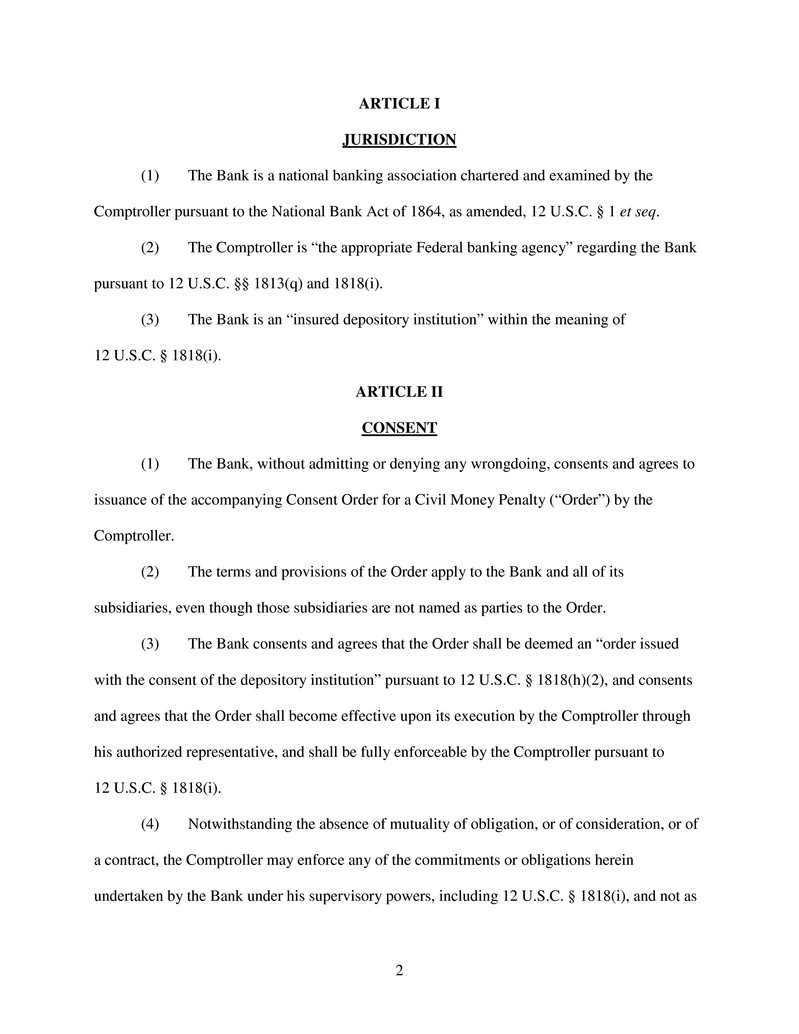
2 ARTICLE I JURISDICTION (1) The Bank is a national banking association chartered and examined by the Comptroller pursuant to the National Bank Act of 1864, as amended, 12 U.S.C. § 1 et seq. (2) The Comptroller is “the appropriate Federal banking agency” regarding the Bank pursuant to 12 U.S.C. §§ 1813(q) and 1818(i). (3) The Bank is an “insured depository institution” within the meaning of 12 U.S.C. § 1818(i). ARTICLE II CONSENT (1) The Bank, without admitting or denying any wrongdoing, consents and agrees to issuance of the accompanying Consent Order for a Civil Money Penalty (“Order”) by the Comptroller. (2) The terms and provisions of the Order apply to the Bank and all of its subsidiaries, even though those subsidiaries are not named as parties to the Order. (3) The Bank consents and agrees that the Order shall be deemed an “order issued with the consent of the depository institution” pursuant to 12 U.S.C. § 1818(h)(2), and consents and agrees that the Order shall become effective upon its execution by the Comptroller through his authorized representative, and shall be fully enforceable by the Comptroller pursuant to 12 U.S.C. § 1818(i). (4) Notwithstanding the absence of mutuality of obligation, or of consideration, or of a contract, the Comptroller may enforce any of the commitments or obligations herein undertaken by the Bank under his supervisory powers, including 12 U.S.C. § 1818(i), and not as
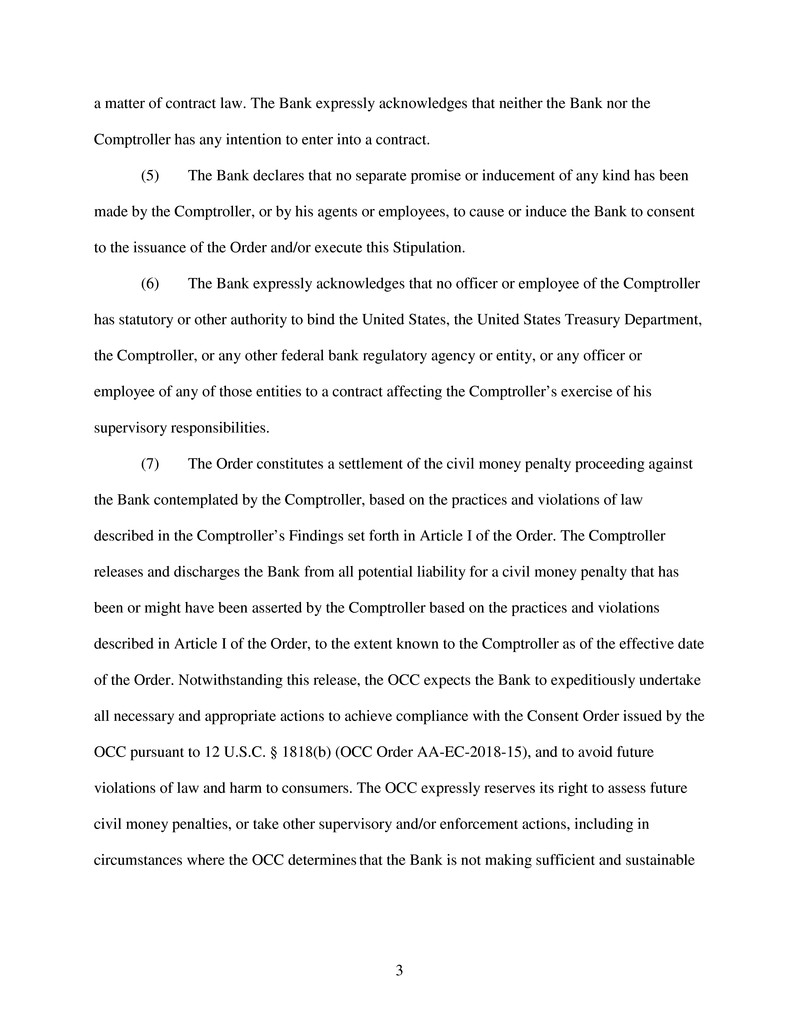
3 a matter of contract law. The Bank expressly acknowledges that neither the Bank nor the Comptroller has any intention to enter into a contract. (5) The Bank declares that no separate promise or inducement of any kind has been made by the Comptroller, or by his agents or employees, to cause or induce the Bank to consent to the issuance of the Order and/or execute this Stipulation. (6) The Bank expressly acknowledges that no officer or employee of the Comptroller has statutory or other authority to bind the United States, the United States Treasury Department, the Comptroller, or any other federal bank regulatory agency or entity, or any officer or employee of any of those entities to a contract affecting the Comptroller’s exercise of his supervisory responsibilities. (7) The Order constitutes a settlement of the civil money penalty proceeding against the Bank contemplated by the Comptroller, based on the practices and violations of law described in the Comptroller’s Findings set forth in Article I of the Order. The Comptroller releases and discharges the Bank from all potential liability for a civil money penalty that has been or might have been asserted by the Comptroller based on the practices and violations described in Article I of the Order, to the extent known to the Comptroller as of the effective date of the Order. Notwithstanding this release, the OCC expects the Bank to expeditiously undertake all necessary and appropriate actions to achieve compliance with the Consent Order issued by the OCC pursuant to 12 U.S.C. § 1818(b) (OCC Order AA-EC-2018-15), and to avoid future violations of law and harm to consumers. The OCC expressly reserves its right to assess future civil money penalties, or take other supervisory and/or enforcement actions, including in circumstances where the OCC determines that the Bank is not making sufficient and sustainable
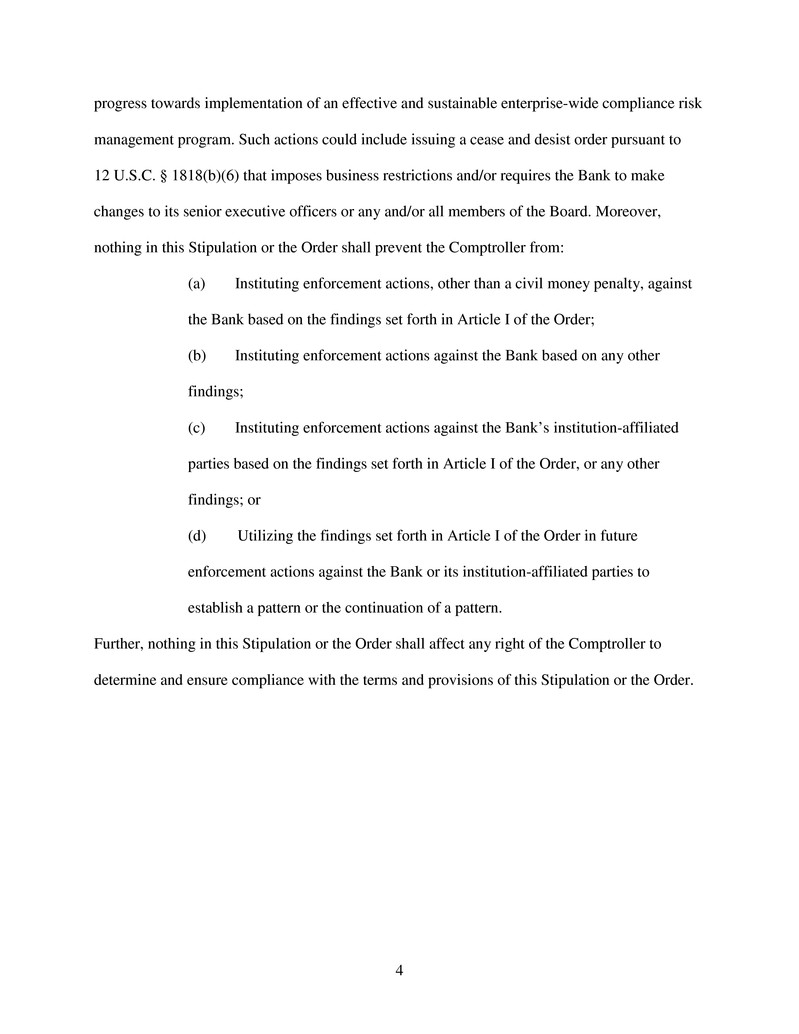
4 progress towards implementation of an effective and sustainable enterprise-wide compliance risk management program. Such actions could include issuing a cease and desist order pursuant to 12 U.S.C. § 1818(b)(6) that imposes business restrictions and/or requires the Bank to make changes to its senior executive officers or any and/or all members of the Board. Moreover, nothing in this Stipulation or the Order shall prevent the Comptroller from: (a) Instituting enforcement actions, other than a civil money penalty, against the Bank based on the findings set forth in Article I of the Order; (b) Instituting enforcement actions against the Bank based on any other findings; (c) Instituting enforcement actions against the Bank’s institution-affiliated parties based on the findings set forth in Article I of the Order, or any other findings; or (d) Utilizing the findings set forth in Article I of the Order in future enforcement actions against the Bank or its institution-affiliated parties to establish a pattern or the continuation of a pattern. Further, nothing in this Stipulation or the Order shall affect any right of the Comptroller to determine and ensure compliance with the terms and provisions of this Stipulation or the Order.
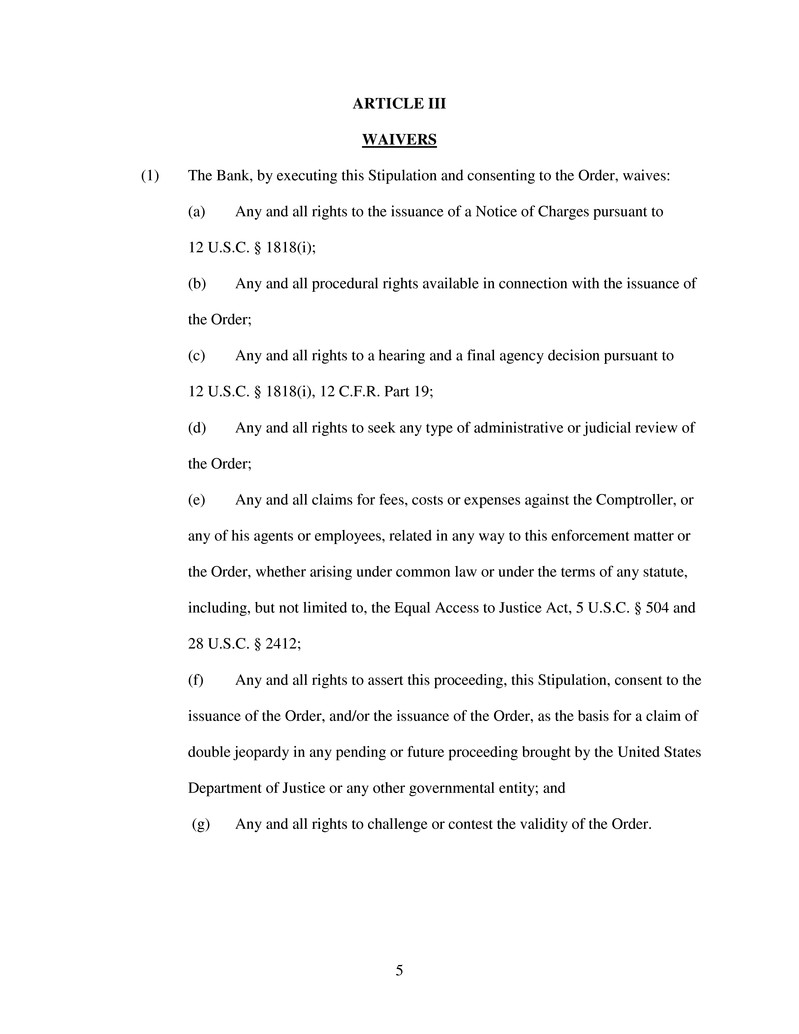
5 ARTICLE III WAIVERS (1) The Bank, by executing this Stipulation and consenting to the Order, waives: (a) Any and all rights to the issuance of a Notice of Charges pursuant to 12 U.S.C. § 1818(i); (b) Any and all procedural rights available in connection with the issuance of the Order; (c) Any and all rights to a hearing and a final agency decision pursuant to 12 U.S.C. § 1818(i), 12 C.F.R. Part 19; (d) Any and all rights to seek any type of administrative or judicial review of the Order; (e) Any and all claims for fees, costs or expenses against the Comptroller, or any of his agents or employees, related in any way to this enforcement matter or the Order, whether arising under common law or under the terms of any statute, including, but not limited to, the Equal Access to Justice Act, 5 U.S.C. § 504 and 28 U.S.C. § 2412; (f) Any and all rights to assert this proceeding, this Stipulation, consent to the issuance of the Order, and/or the issuance of the Order, as the basis for a claim of double jeopardy in any pending or future proceeding brought by the United States Department of Justice or any other governmental entity; and (g) Any and all rights to challenge or contest the validity of the Order.
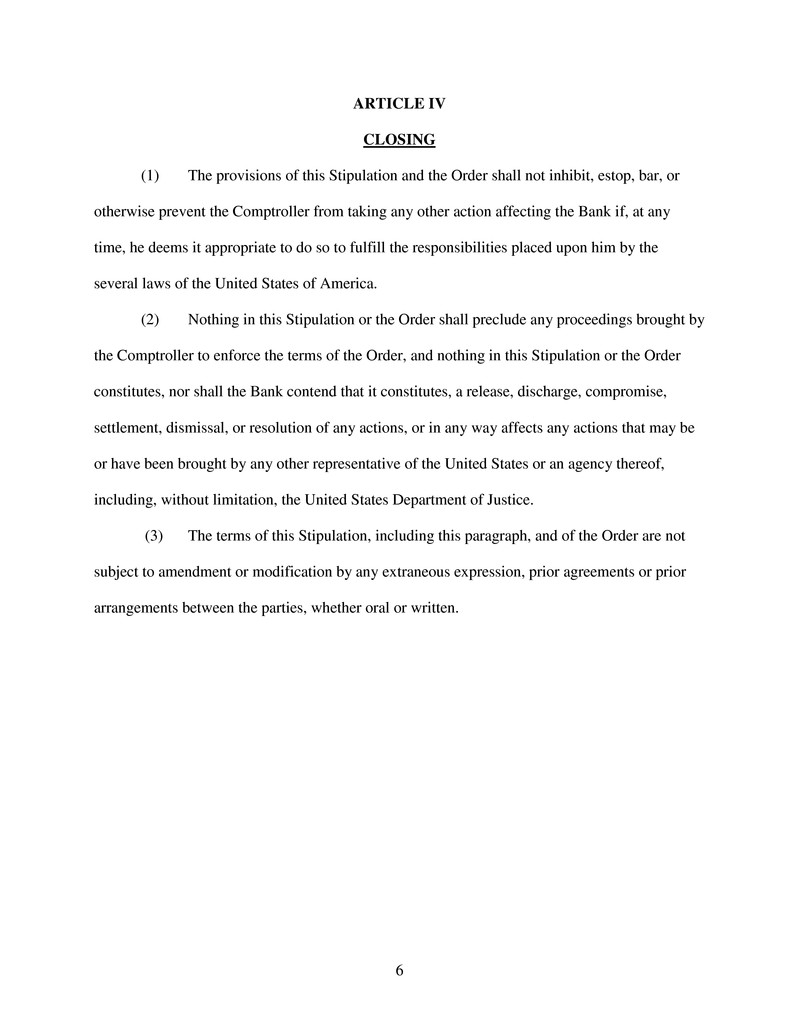
6 ARTICLE IV CLOSING (1) The provisions of this Stipulation and the Order shall not inhibit, estop, bar, or otherwise prevent the Comptroller from taking any other action affecting the Bank if, at any time, he deems it appropriate to do so to fulfill the responsibilities placed upon him by the several laws of the United States of America. (2) Nothing in this Stipulation or the Order shall preclude any proceedings brought by the Comptroller to enforce the terms of the Order, and nothing in this Stipulation or the Order constitutes, nor shall the Bank contend that it constitutes, a release, discharge, compromise, settlement, dismissal, or resolution of any actions, or in any way affects any actions that may be or have been brought by any other representative of the United States or an agency thereof, including, without limitation, the United States Department of Justice. (3) The terms of this Stipulation, including this paragraph, and of the Order are not subject to amendment or modification by any extraneous expression, prior agreements or prior arrangements between the parties, whether oral or written.
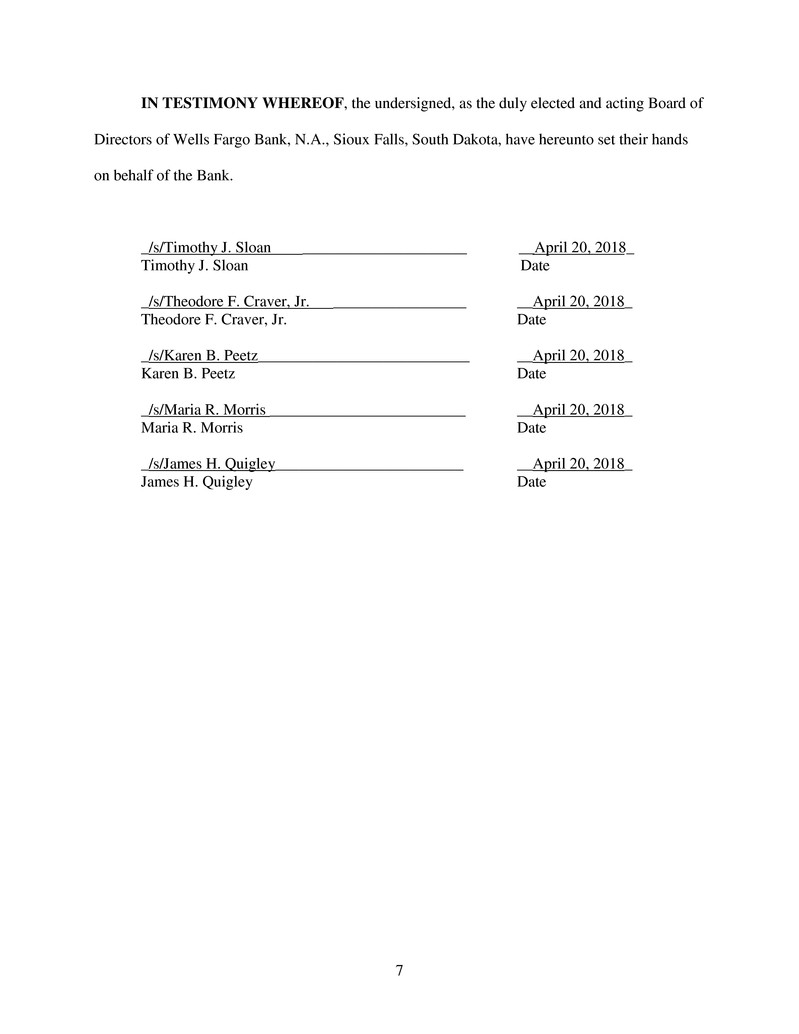
7 IN TESTIMONY WHEREOF, the undersigned, as the duly elected and acting Board of Directors of Wells Fargo Bank, N.A., Sioux Falls, South Dakota, have hereunto set their hands on behalf of the Bank. _/s/Timothy J. Sloan _____________________ Timothy J. Sloan _/s/Theodore F. Craver, Jr. _________________ Theodore F. Craver, Jr. _/s/Karen B. Peetz___________________________ Karen B. Peetz _/s/Maria R. Morris _________________________ Maria R. Morris _/s/James H. Quigley________________________ James H. Quigley __April 20, 2018_ Date __April 20, 2018_ Date __April 20, 2018_ Date __April 20, 2018_ Date __April 20, 2018_ Date
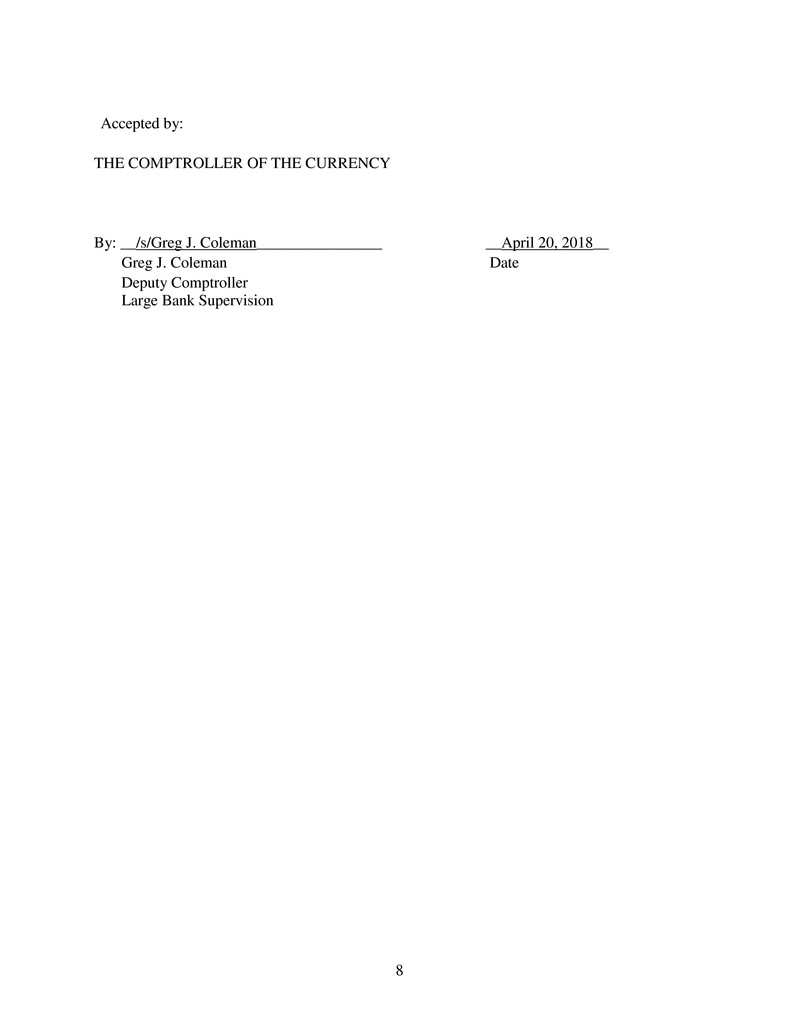
8 Accepted by: THE COMPTROLLER OF THE CURRENCY By: __/s/Greg J. Coleman________________ __April 20, 2018__ Greg J. Coleman Date Deputy Comptroller Large Bank Supervision


















































